Wastewater Treatment Strategies for a Sustainable Future
VerifiedAdded on 2019/09/25
|27
|7596
|421
Report
AI Summary
According to the provided content, wastewater treatment is crucial for maintaining a clean and healthy environment. The assignment discusses various biological wastewater treatment technologies, including aerobic treatment units, membrane bioreactors, activated sludge reactors, and upflow anaerobic sludge blanket systems. These technologies aim to remove pollutants from wastewater, such as biochemical oxygen demand (BOD), chemical oxygen demand (COD), and total organic carbon (TOC). The treatment processes involve microorganisms that break down organic matter, producing cleaner water and reduced pollution. Additionally, the assignment highlights the importance of implementing sustainable biological wastewater treatment systems to mitigate diverse diseases and improve air and water quality.
Contribute Materials
Your contribution can guide someone’s learning journey. Share your
documents today.

WASTEWATER TREATMENT BY BIODEGRADATION
Table of Contents
Abstract 2
1.0 Introduction 3
2.0 Biological treatment technology of organic wastewater 4
3.0 Biological processes for industrial wastewater 5
3.1 Aerobic process 5
3.1.1. Activated sludge reactor 6
Advantages of activated sludge reactor 7
Disadvantages of activated sludge reactor 8
The future of activated sludge 8
3.1.2. Membrane bioreactor 8
Advantages of membrane bioreactor 9
Disadvantages of membrane bioreactor 9
The future of membrane bioreactor 10
Comparison between activated sludge reactor and membrane bioreactor 9
3.2. Anaerobic process 11
3.2.1. Upflow anaerobic sludge blanket reactor 12
Advantages of UASB reactor 13
Disadvantages of UASB reactor 13
The future of UASB reactor 14
3.2.2. Anaerobic biofilter 14
Advantages of Anaerobic biofilter 14
Disadvantages of Anaerobic biofilter 15
The future of anaerobic biofilter 15
3.2.3. Comparison between UASB reactor anaerobic biofilter 14
4.0 Comparison between anaerobic and aerobic wastewater treatment 16
5.0 Combination of Anaerobic and aerobic biodegradation 17
5.1. Oxidation ditch 18
Advantages of oxidation ditch 19
Disadvantages of oxidation ditch 19
5.2. Constructed wetland 19
Advantages of constructed wetland 20
Disadvantages of constructed wetland 20
6.0 Wellbeing contemplations for natural procedures for mechanical
wastewater 21
7.0 Supportability of biodegradation procedure 22
8.0 Conclusions 23
9.0 Abbreviations 24
References 25
Table of Contents
Abstract 2
1.0 Introduction 3
2.0 Biological treatment technology of organic wastewater 4
3.0 Biological processes for industrial wastewater 5
3.1 Aerobic process 5
3.1.1. Activated sludge reactor 6
Advantages of activated sludge reactor 7
Disadvantages of activated sludge reactor 8
The future of activated sludge 8
3.1.2. Membrane bioreactor 8
Advantages of membrane bioreactor 9
Disadvantages of membrane bioreactor 9
The future of membrane bioreactor 10
Comparison between activated sludge reactor and membrane bioreactor 9
3.2. Anaerobic process 11
3.2.1. Upflow anaerobic sludge blanket reactor 12
Advantages of UASB reactor 13
Disadvantages of UASB reactor 13
The future of UASB reactor 14
3.2.2. Anaerobic biofilter 14
Advantages of Anaerobic biofilter 14
Disadvantages of Anaerobic biofilter 15
The future of anaerobic biofilter 15
3.2.3. Comparison between UASB reactor anaerobic biofilter 14
4.0 Comparison between anaerobic and aerobic wastewater treatment 16
5.0 Combination of Anaerobic and aerobic biodegradation 17
5.1. Oxidation ditch 18
Advantages of oxidation ditch 19
Disadvantages of oxidation ditch 19
5.2. Constructed wetland 19
Advantages of constructed wetland 20
Disadvantages of constructed wetland 20
6.0 Wellbeing contemplations for natural procedures for mechanical
wastewater 21
7.0 Supportability of biodegradation procedure 22
8.0 Conclusions 23
9.0 Abbreviations 24
References 25
Secure Best Marks with AI Grader
Need help grading? Try our AI Grader for instant feedback on your assignments.
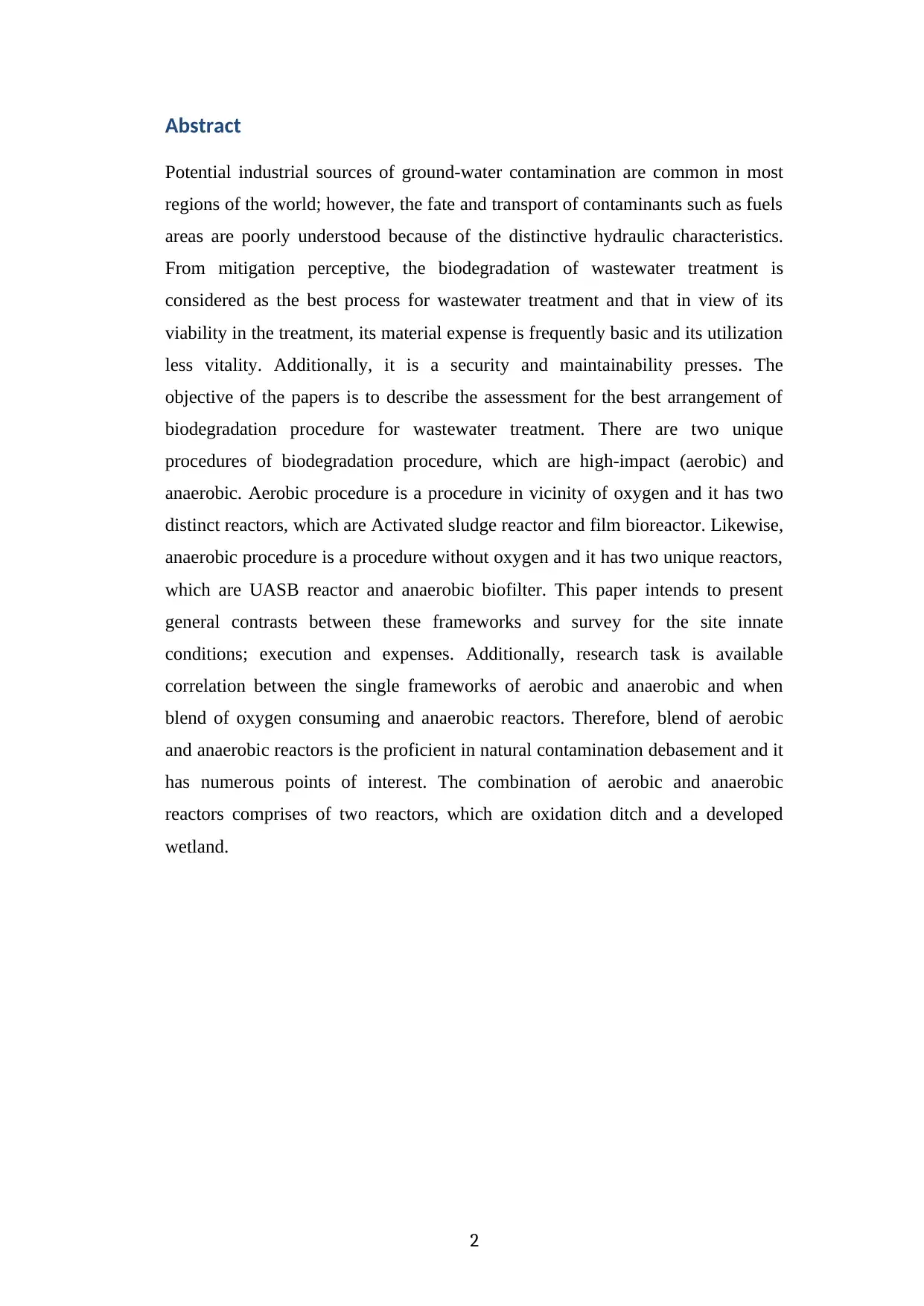
Abstract
Potential industrial sources of ground-water contamination are common in most
regions of the world; however, the fate and transport of contaminants such as fuels
areas are poorly understood because of the distinctive hydraulic characteristics.
From mitigation perceptive, the biodegradation of wastewater treatment is
considered as the best process for wastewater treatment and that in view of its
viability in the treatment, its material expense is frequently basic and its utilization
less vitality. Additionally, it is a security and maintainability presses. The
objective of the papers is to describe the assessment for the best arrangement of
biodegradation procedure for wastewater treatment. There are two unique
procedures of biodegradation procedure, which are high-impact (aerobic) and
anaerobic. Aerobic procedure is a procedure in vicinity of oxygen and it has two
distinct reactors, which are Activated sludge reactor and film bioreactor. Likewise,
anaerobic procedure is a procedure without oxygen and it has two unique reactors,
which are UASB reactor and anaerobic biofilter. This paper intends to present
general contrasts between these frameworks and survey for the site innate
conditions; execution and expenses. Additionally, research task is available
correlation between the single frameworks of aerobic and anaerobic and when
blend of oxygen consuming and anaerobic reactors. Therefore, blend of aerobic
and anaerobic reactors is the proficient in natural contamination debasement and it
has numerous points of interest. The combination of aerobic and anaerobic
reactors comprises of two reactors, which are oxidation ditch and a developed
wetland.
2
Potential industrial sources of ground-water contamination are common in most
regions of the world; however, the fate and transport of contaminants such as fuels
areas are poorly understood because of the distinctive hydraulic characteristics.
From mitigation perceptive, the biodegradation of wastewater treatment is
considered as the best process for wastewater treatment and that in view of its
viability in the treatment, its material expense is frequently basic and its utilization
less vitality. Additionally, it is a security and maintainability presses. The
objective of the papers is to describe the assessment for the best arrangement of
biodegradation procedure for wastewater treatment. There are two unique
procedures of biodegradation procedure, which are high-impact (aerobic) and
anaerobic. Aerobic procedure is a procedure in vicinity of oxygen and it has two
distinct reactors, which are Activated sludge reactor and film bioreactor. Likewise,
anaerobic procedure is a procedure without oxygen and it has two unique reactors,
which are UASB reactor and anaerobic biofilter. This paper intends to present
general contrasts between these frameworks and survey for the site innate
conditions; execution and expenses. Additionally, research task is available
correlation between the single frameworks of aerobic and anaerobic and when
blend of oxygen consuming and anaerobic reactors. Therefore, blend of aerobic
and anaerobic reactors is the proficient in natural contamination debasement and it
has numerous points of interest. The combination of aerobic and anaerobic
reactors comprises of two reactors, which are oxidation ditch and a developed
wetland.
2
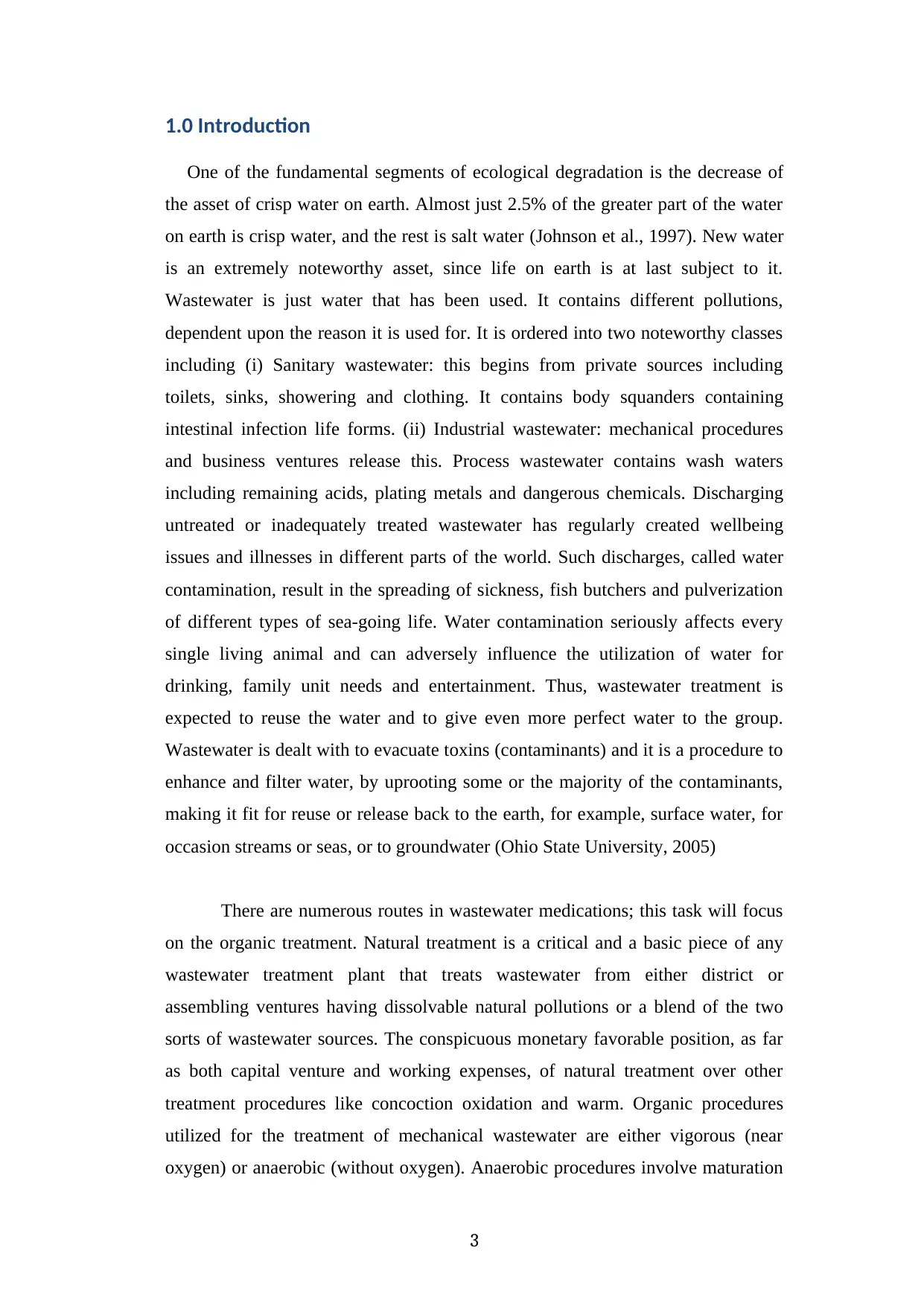
1.0 Introduction
One of the fundamental segments of ecological degradation is the decrease of
the asset of crisp water on earth. Almost just 2.5% of the greater part of the water
on earth is crisp water, and the rest is salt water (Johnson et al., 1997). New water
is an extremely noteworthy asset, since life on earth is at last subject to it.
Wastewater is just water that has been used. It contains different pollutions,
dependent upon the reason it is used for. It is ordered into two noteworthy classes
including (i) Sanitary wastewater: this begins from private sources including
toilets, sinks, showering and clothing. It contains body squanders containing
intestinal infection life forms. (ii) Industrial wastewater: mechanical procedures
and business ventures release this. Process wastewater contains wash waters
including remaining acids, plating metals and dangerous chemicals. Discharging
untreated or inadequately treated wastewater has regularly created wellbeing
issues and illnesses in different parts of the world. Such discharges, called water
contamination, result in the spreading of sickness, fish butchers and pulverization
of different types of sea-going life. Water contamination seriously affects every
single living animal and can adversely influence the utilization of water for
drinking, family unit needs and entertainment. Thus, wastewater treatment is
expected to reuse the water and to give even more perfect water to the group.
Wastewater is dealt with to evacuate toxins (contaminants) and it is a procedure to
enhance and filter water, by uprooting some or the majority of the contaminants,
making it fit for reuse or release back to the earth, for example, surface water, for
occasion streams or seas, or to groundwater (Ohio State University, 2005)
There are numerous routes in wastewater medications; this task will focus
on the organic treatment. Natural treatment is a critical and a basic piece of any
wastewater treatment plant that treats wastewater from either district or
assembling ventures having dissolvable natural pollutions or a blend of the two
sorts of wastewater sources. The conspicuous monetary favorable position, as far
as both capital venture and working expenses, of natural treatment over other
treatment procedures like concoction oxidation and warm. Organic procedures
utilized for the treatment of mechanical wastewater are either vigorous (near
oxygen) or anaerobic (without oxygen). Anaerobic procedures involve maturation
3
One of the fundamental segments of ecological degradation is the decrease of
the asset of crisp water on earth. Almost just 2.5% of the greater part of the water
on earth is crisp water, and the rest is salt water (Johnson et al., 1997). New water
is an extremely noteworthy asset, since life on earth is at last subject to it.
Wastewater is just water that has been used. It contains different pollutions,
dependent upon the reason it is used for. It is ordered into two noteworthy classes
including (i) Sanitary wastewater: this begins from private sources including
toilets, sinks, showering and clothing. It contains body squanders containing
intestinal infection life forms. (ii) Industrial wastewater: mechanical procedures
and business ventures release this. Process wastewater contains wash waters
including remaining acids, plating metals and dangerous chemicals. Discharging
untreated or inadequately treated wastewater has regularly created wellbeing
issues and illnesses in different parts of the world. Such discharges, called water
contamination, result in the spreading of sickness, fish butchers and pulverization
of different types of sea-going life. Water contamination seriously affects every
single living animal and can adversely influence the utilization of water for
drinking, family unit needs and entertainment. Thus, wastewater treatment is
expected to reuse the water and to give even more perfect water to the group.
Wastewater is dealt with to evacuate toxins (contaminants) and it is a procedure to
enhance and filter water, by uprooting some or the majority of the contaminants,
making it fit for reuse or release back to the earth, for example, surface water, for
occasion streams or seas, or to groundwater (Ohio State University, 2005)
There are numerous routes in wastewater medications; this task will focus
on the organic treatment. Natural treatment is a critical and a basic piece of any
wastewater treatment plant that treats wastewater from either district or
assembling ventures having dissolvable natural pollutions or a blend of the two
sorts of wastewater sources. The conspicuous monetary favorable position, as far
as both capital venture and working expenses, of natural treatment over other
treatment procedures like concoction oxidation and warm. Organic procedures
utilized for the treatment of mechanical wastewater are either vigorous (near
oxygen) or anaerobic (without oxygen). Anaerobic procedures involve maturation
3
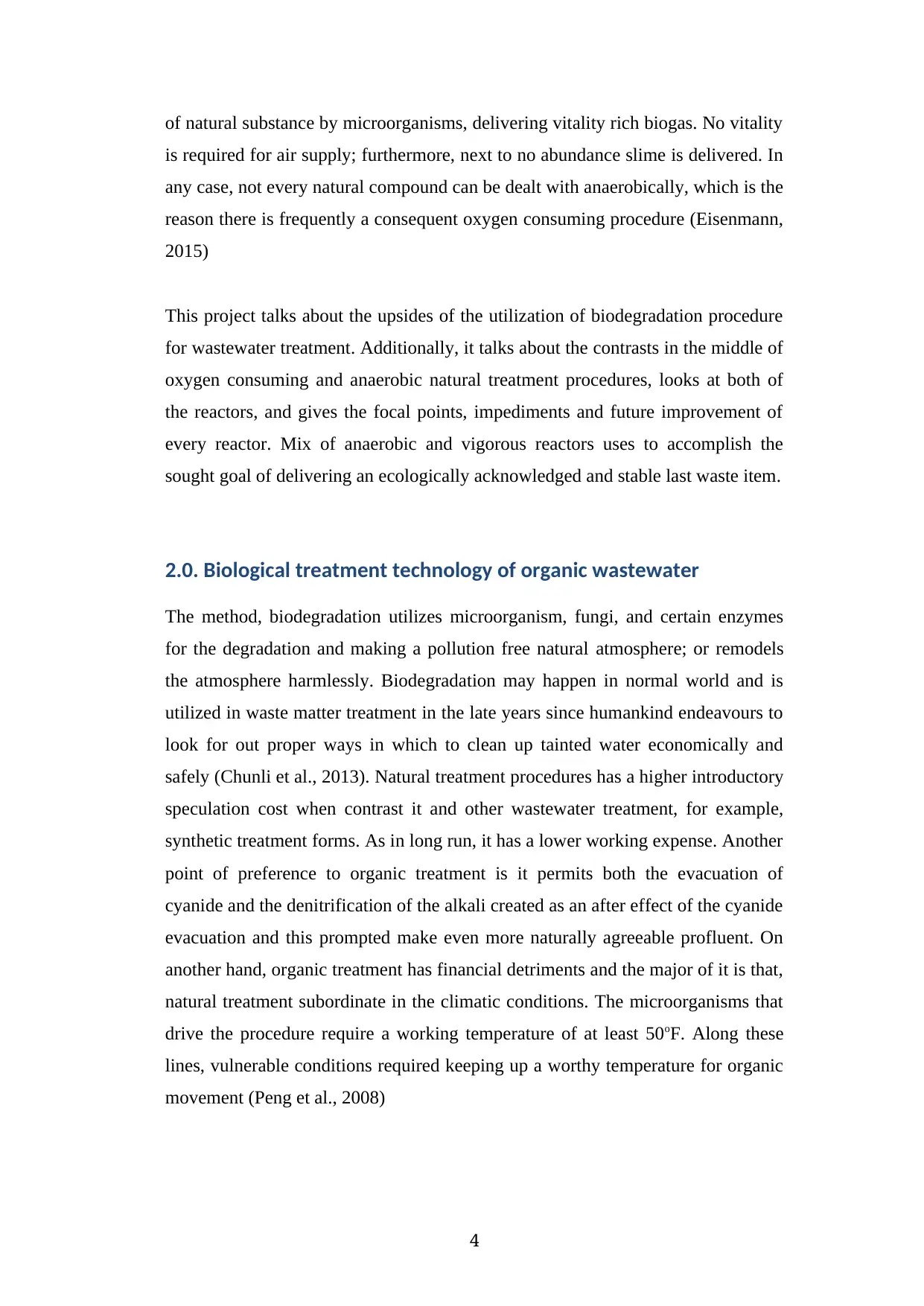
of natural substance by microorganisms, delivering vitality rich biogas. No vitality
is required for air supply; furthermore, next to no abundance slime is delivered. In
any case, not every natural compound can be dealt with anaerobically, which is the
reason there is frequently a consequent oxygen consuming procedure (Eisenmann,
2015)
This project talks about the upsides of the utilization of biodegradation procedure
for wastewater treatment. Additionally, it talks about the contrasts in the middle of
oxygen consuming and anaerobic natural treatment procedures, looks at both of
the reactors, and gives the focal points, impediments and future improvement of
every reactor. Mix of anaerobic and vigorous reactors uses to accomplish the
sought goal of delivering an ecologically acknowledged and stable last waste item.
2.0. Biological treatment technology of organic wastewater
The method, biodegradation utilizes microorganism, fungi, and certain enzymes
for the degradation and making a pollution free natural atmosphere; or remodels
the atmosphere harmlessly. Biodegradation may happen in normal world and is
utilized in waste matter treatment in the late years since humankind endeavours to
look for out proper ways in which to clean up tainted water economically and
safely (Chunli et al., 2013). Natural treatment procedures has a higher introductory
speculation cost when contrast it and other wastewater treatment, for example,
synthetic treatment forms. As in long run, it has a lower working expense. Another
point of preference to organic treatment is it permits both the evacuation of
cyanide and the denitrification of the alkali created as an after effect of the cyanide
evacuation and this prompted make even more naturally agreeable profluent. On
another hand, organic treatment has financial detriments and the major of it is that,
natural treatment subordinate in the climatic conditions. The microorganisms that
drive the procedure require a working temperature of at least 50oF. Along these
lines, vulnerable conditions required keeping up a worthy temperature for organic
movement (Peng et al., 2008)
4
is required for air supply; furthermore, next to no abundance slime is delivered. In
any case, not every natural compound can be dealt with anaerobically, which is the
reason there is frequently a consequent oxygen consuming procedure (Eisenmann,
2015)
This project talks about the upsides of the utilization of biodegradation procedure
for wastewater treatment. Additionally, it talks about the contrasts in the middle of
oxygen consuming and anaerobic natural treatment procedures, looks at both of
the reactors, and gives the focal points, impediments and future improvement of
every reactor. Mix of anaerobic and vigorous reactors uses to accomplish the
sought goal of delivering an ecologically acknowledged and stable last waste item.
2.0. Biological treatment technology of organic wastewater
The method, biodegradation utilizes microorganism, fungi, and certain enzymes
for the degradation and making a pollution free natural atmosphere; or remodels
the atmosphere harmlessly. Biodegradation may happen in normal world and is
utilized in waste matter treatment in the late years since humankind endeavours to
look for out proper ways in which to clean up tainted water economically and
safely (Chunli et al., 2013). Natural treatment procedures has a higher introductory
speculation cost when contrast it and other wastewater treatment, for example,
synthetic treatment forms. As in long run, it has a lower working expense. Another
point of preference to organic treatment is it permits both the evacuation of
cyanide and the denitrification of the alkali created as an after effect of the cyanide
evacuation and this prompted make even more naturally agreeable profluent. On
another hand, organic treatment has financial detriments and the major of it is that,
natural treatment subordinate in the climatic conditions. The microorganisms that
drive the procedure require a working temperature of at least 50oF. Along these
lines, vulnerable conditions required keeping up a worthy temperature for organic
movement (Peng et al., 2008)
4
Paraphrase This Document
Need a fresh take? Get an instant paraphrase of this document with our AI Paraphraser
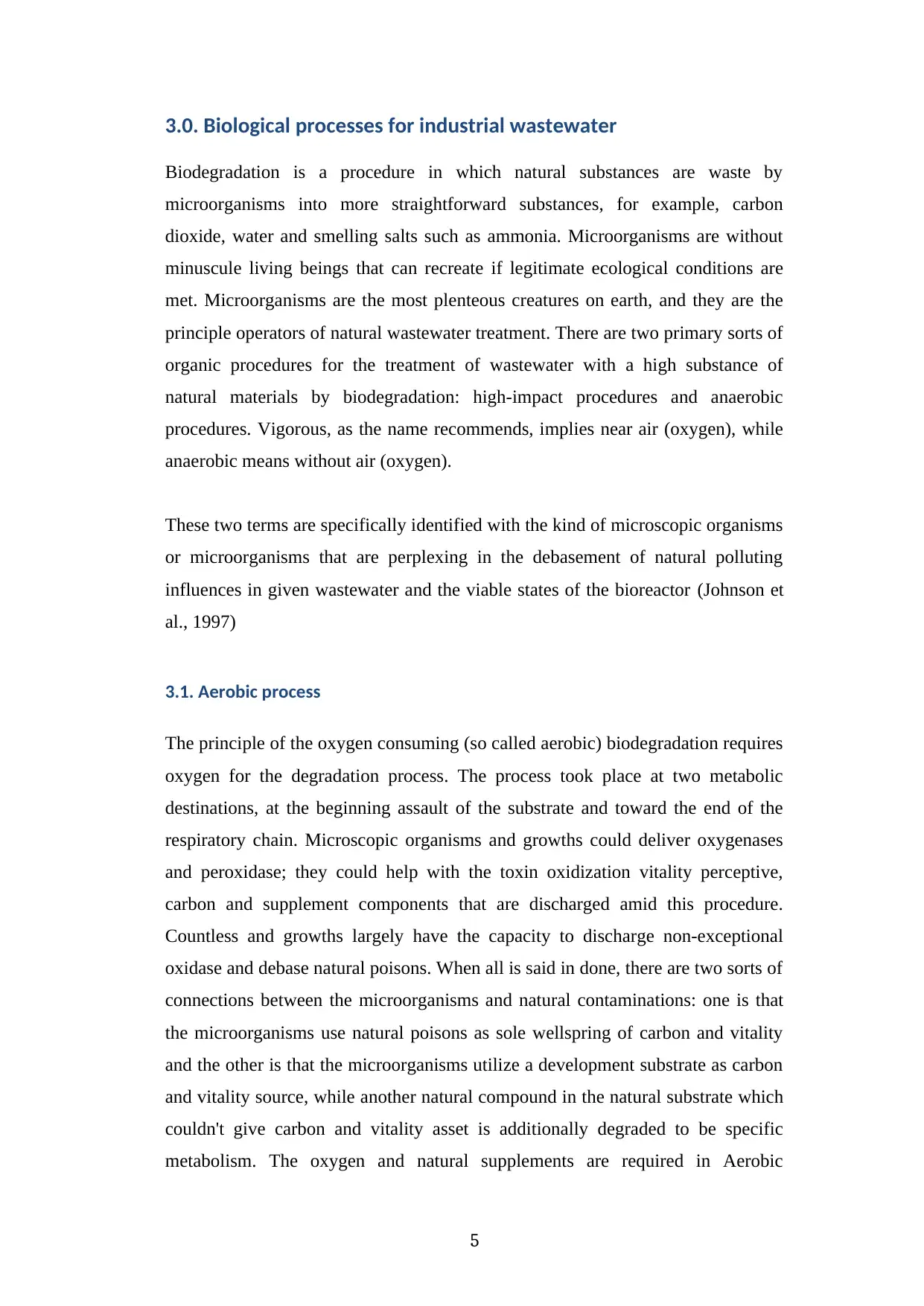
3.0. Biological processes for industrial wastewater
Biodegradation is a procedure in which natural substances are waste by
microorganisms into more straightforward substances, for example, carbon
dioxide, water and smelling salts such as ammonia. Microorganisms are without
minuscule living beings that can recreate if legitimate ecological conditions are
met. Microorganisms are the most plenteous creatures on earth, and they are the
principle operators of natural wastewater treatment. There are two primary sorts of
organic procedures for the treatment of wastewater with a high substance of
natural materials by biodegradation: high-impact procedures and anaerobic
procedures. Vigorous, as the name recommends, implies near air (oxygen), while
anaerobic means without air (oxygen).
These two terms are specifically identified with the kind of microscopic organisms
or microorganisms that are perplexing in the debasement of natural polluting
influences in given wastewater and the viable states of the bioreactor (Johnson et
al., 1997)
3.1. Aerobic process
The principle of the oxygen consuming (so called aerobic) biodegradation requires
oxygen for the degradation process. The process took place at two metabolic
destinations, at the beginning assault of the substrate and toward the end of the
respiratory chain. Microscopic organisms and growths could deliver oxygenases
and peroxidase; they could help with the toxin oxidization vitality perceptive,
carbon and supplement components that are discharged amid this procedure.
Countless and growths largely have the capacity to discharge non-exceptional
oxidase and debase natural poisons. When all is said in done, there are two sorts of
connections between the microorganisms and natural contaminations: one is that
the microorganisms use natural poisons as sole wellspring of carbon and vitality
and the other is that the microorganisms utilize a development substrate as carbon
and vitality source, while another natural compound in the natural substrate which
couldn't give carbon and vitality asset is additionally degraded to be specific
metabolism. The oxygen and natural supplements are required in Aerobic
5
Biodegradation is a procedure in which natural substances are waste by
microorganisms into more straightforward substances, for example, carbon
dioxide, water and smelling salts such as ammonia. Microorganisms are without
minuscule living beings that can recreate if legitimate ecological conditions are
met. Microorganisms are the most plenteous creatures on earth, and they are the
principle operators of natural wastewater treatment. There are two primary sorts of
organic procedures for the treatment of wastewater with a high substance of
natural materials by biodegradation: high-impact procedures and anaerobic
procedures. Vigorous, as the name recommends, implies near air (oxygen), while
anaerobic means without air (oxygen).
These two terms are specifically identified with the kind of microscopic organisms
or microorganisms that are perplexing in the debasement of natural polluting
influences in given wastewater and the viable states of the bioreactor (Johnson et
al., 1997)
3.1. Aerobic process
The principle of the oxygen consuming (so called aerobic) biodegradation requires
oxygen for the degradation process. The process took place at two metabolic
destinations, at the beginning assault of the substrate and toward the end of the
respiratory chain. Microscopic organisms and growths could deliver oxygenases
and peroxidase; they could help with the toxin oxidization vitality perceptive,
carbon and supplement components that are discharged amid this procedure.
Countless and growths largely have the capacity to discharge non-exceptional
oxidase and debase natural poisons. When all is said in done, there are two sorts of
connections between the microorganisms and natural contaminations: one is that
the microorganisms use natural poisons as sole wellspring of carbon and vitality
and the other is that the microorganisms utilize a development substrate as carbon
and vitality source, while another natural compound in the natural substrate which
couldn't give carbon and vitality asset is additionally degraded to be specific
metabolism. The oxygen and natural supplements are required in Aerobic
5
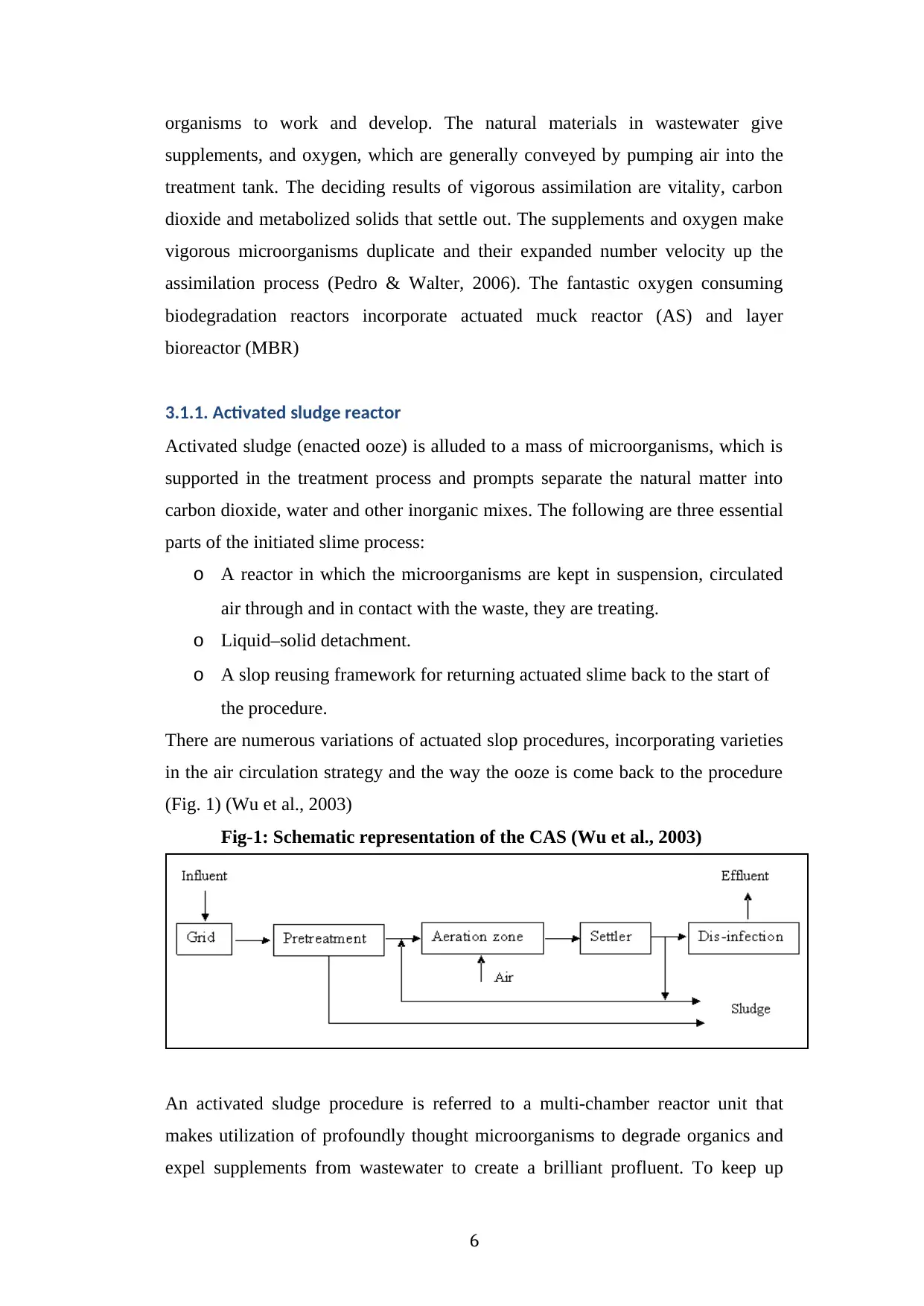
organisms to work and develop. The natural materials in wastewater give
supplements, and oxygen, which are generally conveyed by pumping air into the
treatment tank. The deciding results of vigorous assimilation are vitality, carbon
dioxide and metabolized solids that settle out. The supplements and oxygen make
vigorous microorganisms duplicate and their expanded number velocity up the
assimilation process (Pedro & Walter, 2006). The fantastic oxygen consuming
biodegradation reactors incorporate actuated muck reactor (AS) and layer
bioreactor (MBR)
3.1.1. Activated sludge reactor
Activated sludge (enacted ooze) is alluded to a mass of microorganisms, which is
supported in the treatment process and prompts separate the natural matter into
carbon dioxide, water and other inorganic mixes. The following are three essential
parts of the initiated slime process:
o A reactor in which the microorganisms are kept in suspension, circulated
air through and in contact with the waste, they are treating.
o Liquid–solid detachment.
o A slop reusing framework for returning actuated slime back to the start of
the procedure.
There are numerous variations of actuated slop procedures, incorporating varieties
in the air circulation strategy and the way the ooze is come back to the procedure
(Fig. 1) (Wu et al., 2003)
Fig-1: Schematic representation of the CAS (Wu et al., 2003)
An activated sludge procedure is referred to a multi-chamber reactor unit that
makes utilization of profoundly thought microorganisms to degrade organics and
expel supplements from wastewater to create a brilliant profluent. To keep up
6
supplements, and oxygen, which are generally conveyed by pumping air into the
treatment tank. The deciding results of vigorous assimilation are vitality, carbon
dioxide and metabolized solids that settle out. The supplements and oxygen make
vigorous microorganisms duplicate and their expanded number velocity up the
assimilation process (Pedro & Walter, 2006). The fantastic oxygen consuming
biodegradation reactors incorporate actuated muck reactor (AS) and layer
bioreactor (MBR)
3.1.1. Activated sludge reactor
Activated sludge (enacted ooze) is alluded to a mass of microorganisms, which is
supported in the treatment process and prompts separate the natural matter into
carbon dioxide, water and other inorganic mixes. The following are three essential
parts of the initiated slime process:
o A reactor in which the microorganisms are kept in suspension, circulated
air through and in contact with the waste, they are treating.
o Liquid–solid detachment.
o A slop reusing framework for returning actuated slime back to the start of
the procedure.
There are numerous variations of actuated slop procedures, incorporating varieties
in the air circulation strategy and the way the ooze is come back to the procedure
(Fig. 1) (Wu et al., 2003)
Fig-1: Schematic representation of the CAS (Wu et al., 2003)
An activated sludge procedure is referred to a multi-chamber reactor unit that
makes utilization of profoundly thought microorganisms to degrade organics and
expel supplements from wastewater to create a brilliant profluent. To keep up
6

vigorous conditions and to keep the actuated slop suspended, a nonstop and all
around timed supply of oxygen is required.
Fig-2: Activated sludge process (Ahmed & Lan, 2012)
The high-impact microbes are flourished as they go through the air circulation
tank, and they increase quickly with adequate nourishment and oxygen. The waste
is required time somewhere around 4 and 8 hours to achieve the end of the tank
and right now the microscopic organisms have practically utilized the greater part
of the natural matter to create new cells. The living beings settle at the base of the
clarifier tank, isolating from the clearer water. This slime is pumped back to the air
circulation tank where it is blended with the approaching wastewater or is expelled
from the framework as overabundance, a procedure called squandering. The
generally clear fluid over the slime, the supernatant, is sent on for further treatment
as required (Fig-2) (NESC, 2013)
Advantages of activated sludge reactor
i. It has high imperviousness to natural and water powered stun loads.
ii. It can be worked at a scope of natural and water driven stacking rates.
iii. It has high decrease of biochemical oxygen request (BOD) and pathogens,
which is up to 99%.
iv. It has high supplement evacuation.
v. It is conceivable to alter the reactor to meet particular release limits (Wu et
al., 2003)
7
around timed supply of oxygen is required.
Fig-2: Activated sludge process (Ahmed & Lan, 2012)
The high-impact microbes are flourished as they go through the air circulation
tank, and they increase quickly with adequate nourishment and oxygen. The waste
is required time somewhere around 4 and 8 hours to achieve the end of the tank
and right now the microscopic organisms have practically utilized the greater part
of the natural matter to create new cells. The living beings settle at the base of the
clarifier tank, isolating from the clearer water. This slime is pumped back to the air
circulation tank where it is blended with the approaching wastewater or is expelled
from the framework as overabundance, a procedure called squandering. The
generally clear fluid over the slime, the supernatant, is sent on for further treatment
as required (Fig-2) (NESC, 2013)
Advantages of activated sludge reactor
i. It has high imperviousness to natural and water powered stun loads.
ii. It can be worked at a scope of natural and water driven stacking rates.
iii. It has high decrease of biochemical oxygen request (BOD) and pathogens,
which is up to 99%.
iv. It has high supplement evacuation.
v. It is conceivable to alter the reactor to meet particular release limits (Wu et
al., 2003)
7
Secure Best Marks with AI Grader
Need help grading? Try our AI Grader for instant feedback on your assignments.

Disadvantages of activated sludge reactor
i. It needs high energy. So a consistent wellspring of power is required.
ii. The capital and working expenses are extremely high; hence it needs gifted
persons to work and for upkeep.
iii. It is difficult to give all parts and materials (locally).
iv. A gifted outline and development are required.
v. Sludge and perhaps emanating require further treatment and/or fitting
discharge (Wu et al., 2003)
The future actuated sludge
The things can make Activated Sludge is more proficiency are that lessen the
region required to wastewater from industry; build up the nitrous oxide sensors;
another era of respirometers; and natural observing frameworks to keep an eye on
the strength of the organic piece of the procedure. The Activated Sludge plants
will be predictable to accomplish more. As Activated Sludge need steady
wellspring of power, the proposition to improvement in future is to reuse the
vitality that was made from the procedure to work the machine of industrial
(Grievson, 2014)
3.1.2 Membrane bioreactor
MBR is the combination of a membrane process like microfiltration and
ultrafiltration with a suspended development bioreactor and is presently broadly
utilized for metropolitan and mechanical wastewater treatment. The plan
representation of the reactor is shown in Fig-3 (Ahmed & Lan, 2012).
Fig-3: The schematic representation of a MBR (Ahmed & Lan, 2012)
The principle of this procedure is almost the same as enacted ooze procedure, with
the exception of that rather than division of water and slop through settlement, the
8
i. It needs high energy. So a consistent wellspring of power is required.
ii. The capital and working expenses are extremely high; hence it needs gifted
persons to work and for upkeep.
iii. It is difficult to give all parts and materials (locally).
iv. A gifted outline and development are required.
v. Sludge and perhaps emanating require further treatment and/or fitting
discharge (Wu et al., 2003)
The future actuated sludge
The things can make Activated Sludge is more proficiency are that lessen the
region required to wastewater from industry; build up the nitrous oxide sensors;
another era of respirometers; and natural observing frameworks to keep an eye on
the strength of the organic piece of the procedure. The Activated Sludge plants
will be predictable to accomplish more. As Activated Sludge need steady
wellspring of power, the proposition to improvement in future is to reuse the
vitality that was made from the procedure to work the machine of industrial
(Grievson, 2014)
3.1.2 Membrane bioreactor
MBR is the combination of a membrane process like microfiltration and
ultrafiltration with a suspended development bioreactor and is presently broadly
utilized for metropolitan and mechanical wastewater treatment. The plan
representation of the reactor is shown in Fig-3 (Ahmed & Lan, 2012).
Fig-3: The schematic representation of a MBR (Ahmed & Lan, 2012)
The principle of this procedure is almost the same as enacted ooze procedure, with
the exception of that rather than division of water and slop through settlement, the
8
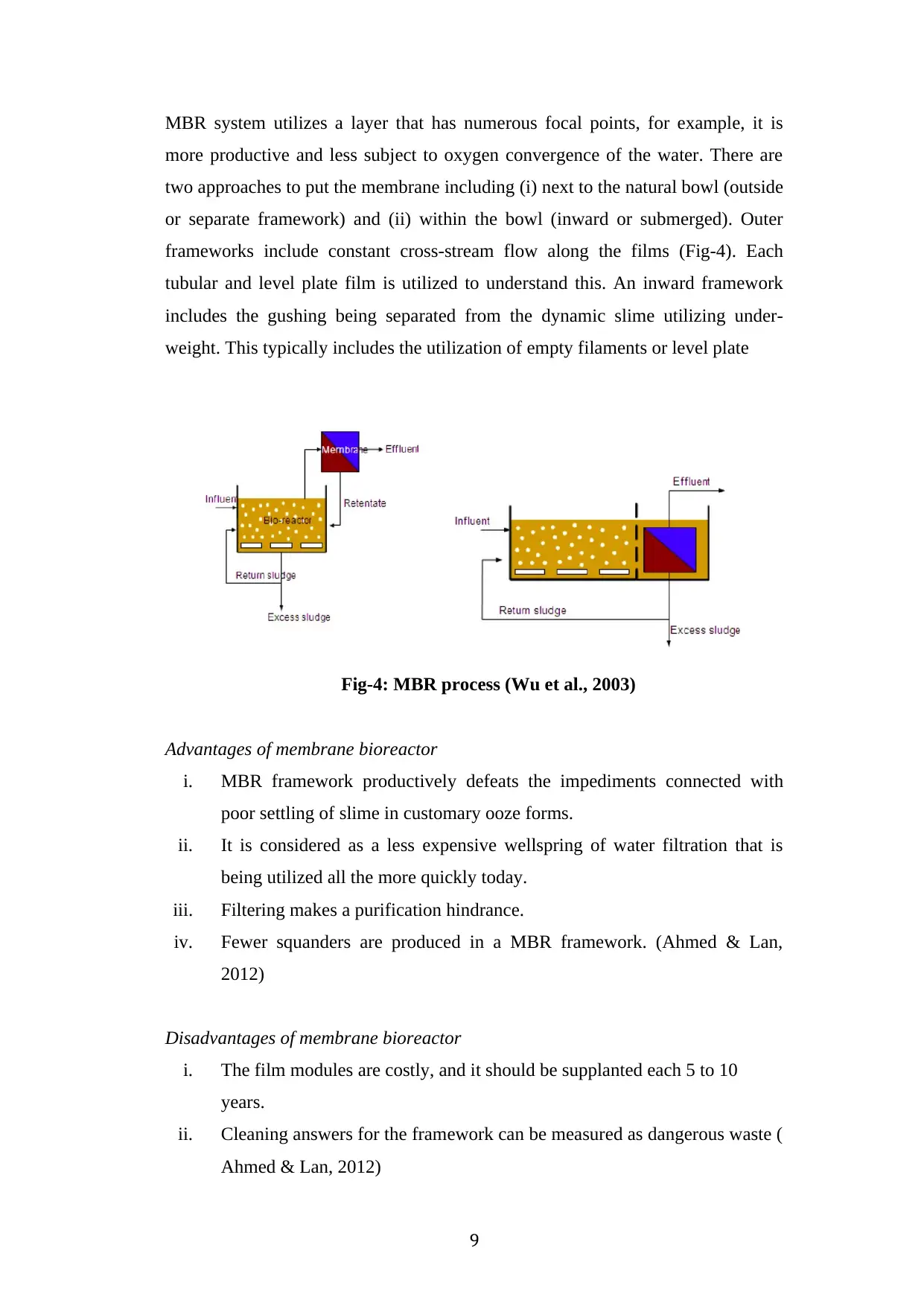
MBR system utilizes a layer that has numerous focal points, for example, it is
more productive and less subject to oxygen convergence of the water. There are
two approaches to put the membrane including (i) next to the natural bowl (outside
or separate framework) and (ii) within the bowl (inward or submerged). Outer
frameworks include constant cross-stream flow along the films (Fig-4). Each
tubular and level plate film is utilized to understand this. An inward framework
includes the gushing being separated from the dynamic slime utilizing under-
weight. This typically includes the utilization of empty filaments or level plate
Fig-4: MBR process (Wu et al., 2003)
Advantages of membrane bioreactor
i. MBR framework productively defeats the impediments connected with
poor settling of slime in customary ooze forms.
ii. It is considered as a less expensive wellspring of water filtration that is
being utilized all the more quickly today.
iii. Filtering makes a purification hindrance.
iv. Fewer squanders are produced in a MBR framework. (Ahmed & Lan,
2012)
Disadvantages of membrane bioreactor
i. The film modules are costly, and it should be supplanted each 5 to 10
years.
ii. Cleaning answers for the framework can be measured as dangerous waste (
Ahmed & Lan, 2012)
9
more productive and less subject to oxygen convergence of the water. There are
two approaches to put the membrane including (i) next to the natural bowl (outside
or separate framework) and (ii) within the bowl (inward or submerged). Outer
frameworks include constant cross-stream flow along the films (Fig-4). Each
tubular and level plate film is utilized to understand this. An inward framework
includes the gushing being separated from the dynamic slime utilizing under-
weight. This typically includes the utilization of empty filaments or level plate
Fig-4: MBR process (Wu et al., 2003)
Advantages of membrane bioreactor
i. MBR framework productively defeats the impediments connected with
poor settling of slime in customary ooze forms.
ii. It is considered as a less expensive wellspring of water filtration that is
being utilized all the more quickly today.
iii. Filtering makes a purification hindrance.
iv. Fewer squanders are produced in a MBR framework. (Ahmed & Lan,
2012)
Disadvantages of membrane bioreactor
i. The film modules are costly, and it should be supplanted each 5 to 10
years.
ii. Cleaning answers for the framework can be measured as dangerous waste (
Ahmed & Lan, 2012)
9
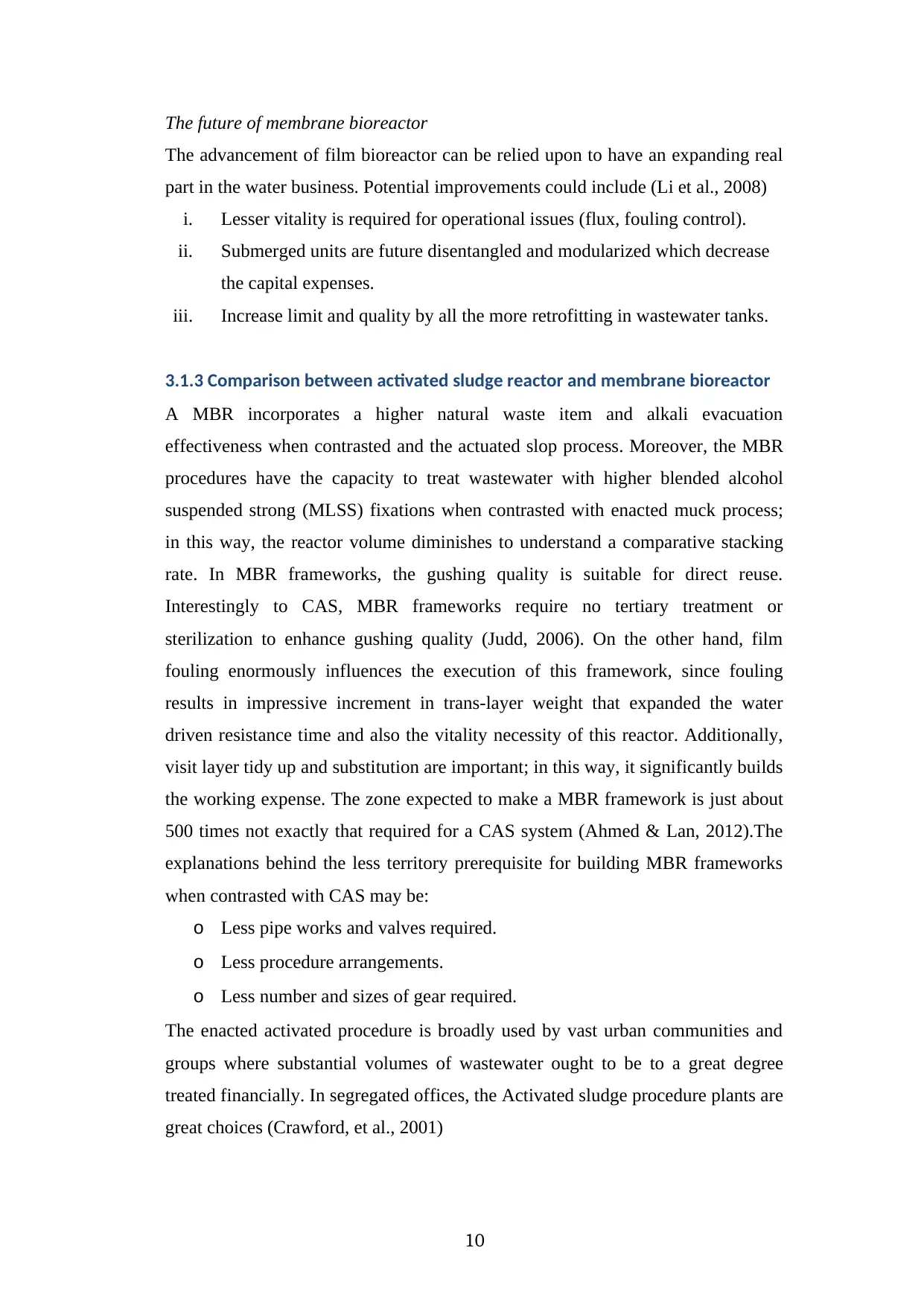
The future of membrane bioreactor
The advancement of film bioreactor can be relied upon to have an expanding real
part in the water business. Potential improvements could include (Li et al., 2008)
i. Lesser vitality is required for operational issues (flux, fouling control).
ii. Submerged units are future disentangled and modularized which decrease
the capital expenses.
iii. Increase limit and quality by all the more retrofitting in wastewater tanks.
3.1.3 Comparison between activated sludge reactor and membrane bioreactor
A MBR incorporates a higher natural waste item and alkali evacuation
effectiveness when contrasted and the actuated slop process. Moreover, the MBR
procedures have the capacity to treat wastewater with higher blended alcohol
suspended strong (MLSS) fixations when contrasted with enacted muck process;
in this way, the reactor volume diminishes to understand a comparative stacking
rate. In MBR frameworks, the gushing quality is suitable for direct reuse.
Interestingly to CAS, MBR frameworks require no tertiary treatment or
sterilization to enhance gushing quality (Judd, 2006). On the other hand, film
fouling enormously influences the execution of this framework, since fouling
results in impressive increment in trans-layer weight that expanded the water
driven resistance time and also the vitality necessity of this reactor. Additionally,
visit layer tidy up and substitution are important; in this way, it significantly builds
the working expense. The zone expected to make a MBR framework is just about
500 times not exactly that required for a CAS system (Ahmed & Lan, 2012).The
explanations behind the less territory prerequisite for building MBR frameworks
when contrasted with CAS may be:
o Less pipe works and valves required.
o Less procedure arrangements.
o Less number and sizes of gear required.
The enacted activated procedure is broadly used by vast urban communities and
groups where substantial volumes of wastewater ought to be to a great degree
treated financially. In segregated offices, the Activated sludge procedure plants are
great choices (Crawford, et al., 2001)
10
The advancement of film bioreactor can be relied upon to have an expanding real
part in the water business. Potential improvements could include (Li et al., 2008)
i. Lesser vitality is required for operational issues (flux, fouling control).
ii. Submerged units are future disentangled and modularized which decrease
the capital expenses.
iii. Increase limit and quality by all the more retrofitting in wastewater tanks.
3.1.3 Comparison between activated sludge reactor and membrane bioreactor
A MBR incorporates a higher natural waste item and alkali evacuation
effectiveness when contrasted and the actuated slop process. Moreover, the MBR
procedures have the capacity to treat wastewater with higher blended alcohol
suspended strong (MLSS) fixations when contrasted with enacted muck process;
in this way, the reactor volume diminishes to understand a comparative stacking
rate. In MBR frameworks, the gushing quality is suitable for direct reuse.
Interestingly to CAS, MBR frameworks require no tertiary treatment or
sterilization to enhance gushing quality (Judd, 2006). On the other hand, film
fouling enormously influences the execution of this framework, since fouling
results in impressive increment in trans-layer weight that expanded the water
driven resistance time and also the vitality necessity of this reactor. Additionally,
visit layer tidy up and substitution are important; in this way, it significantly builds
the working expense. The zone expected to make a MBR framework is just about
500 times not exactly that required for a CAS system (Ahmed & Lan, 2012).The
explanations behind the less territory prerequisite for building MBR frameworks
when contrasted with CAS may be:
o Less pipe works and valves required.
o Less procedure arrangements.
o Less number and sizes of gear required.
The enacted activated procedure is broadly used by vast urban communities and
groups where substantial volumes of wastewater ought to be to a great degree
treated financially. In segregated offices, the Activated sludge procedure plants are
great choices (Crawford, et al., 2001)
10
Paraphrase This Document
Need a fresh take? Get an instant paraphrase of this document with our AI Paraphraser
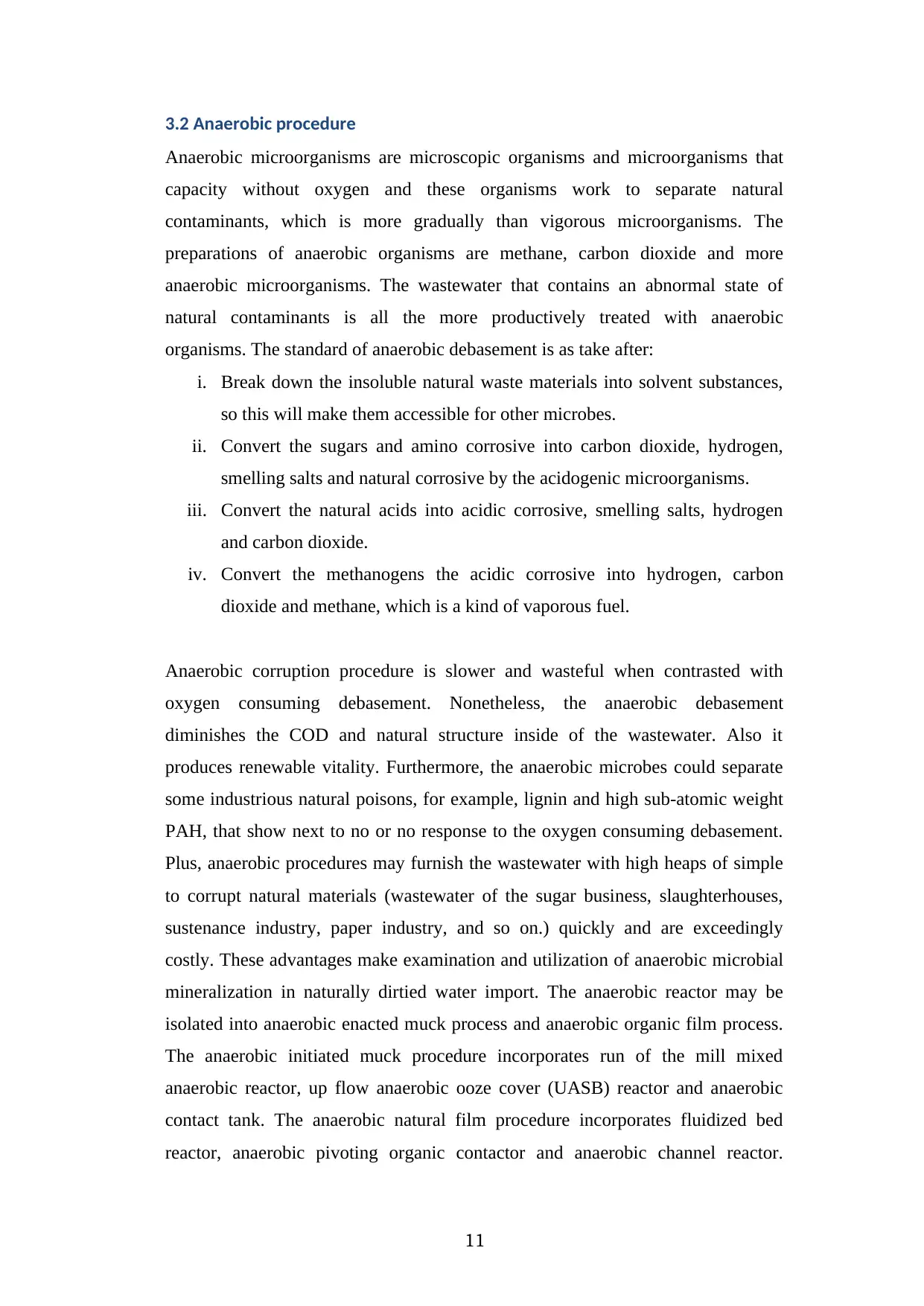
3.2 Anaerobic procedure
Anaerobic microorganisms are microscopic organisms and microorganisms that
capacity without oxygen and these organisms work to separate natural
contaminants, which is more gradually than vigorous microorganisms. The
preparations of anaerobic organisms are methane, carbon dioxide and more
anaerobic microorganisms. The wastewater that contains an abnormal state of
natural contaminants is all the more productively treated with anaerobic
organisms. The standard of anaerobic debasement is as take after:
i. Break down the insoluble natural waste materials into solvent substances,
so this will make them accessible for other microbes.
ii. Convert the sugars and amino corrosive into carbon dioxide, hydrogen,
smelling salts and natural corrosive by the acidogenic microorganisms.
iii. Convert the natural acids into acidic corrosive, smelling salts, hydrogen
and carbon dioxide.
iv. Convert the methanogens the acidic corrosive into hydrogen, carbon
dioxide and methane, which is a kind of vaporous fuel.
Anaerobic corruption procedure is slower and wasteful when contrasted with
oxygen consuming debasement. Nonetheless, the anaerobic debasement
diminishes the COD and natural structure inside of the wastewater. Also it
produces renewable vitality. Furthermore, the anaerobic microbes could separate
some industrious natural poisons, for example, lignin and high sub-atomic weight
PAH, that show next to no or no response to the oxygen consuming debasement.
Plus, anaerobic procedures may furnish the wastewater with high heaps of simple
to corrupt natural materials (wastewater of the sugar business, slaughterhouses,
sustenance industry, paper industry, and so on.) quickly and are exceedingly
costly. These advantages make examination and utilization of anaerobic microbial
mineralization in naturally dirtied water import. The anaerobic reactor may be
isolated into anaerobic enacted muck process and anaerobic organic film process.
The anaerobic initiated muck procedure incorporates run of the mill mixed
anaerobic reactor, up flow anaerobic ooze cover (UASB) reactor and anaerobic
contact tank. The anaerobic natural film procedure incorporates fluidized bed
reactor, anaerobic pivoting organic contactor and anaerobic channel reactor.
11
Anaerobic microorganisms are microscopic organisms and microorganisms that
capacity without oxygen and these organisms work to separate natural
contaminants, which is more gradually than vigorous microorganisms. The
preparations of anaerobic organisms are methane, carbon dioxide and more
anaerobic microorganisms. The wastewater that contains an abnormal state of
natural contaminants is all the more productively treated with anaerobic
organisms. The standard of anaerobic debasement is as take after:
i. Break down the insoluble natural waste materials into solvent substances,
so this will make them accessible for other microbes.
ii. Convert the sugars and amino corrosive into carbon dioxide, hydrogen,
smelling salts and natural corrosive by the acidogenic microorganisms.
iii. Convert the natural acids into acidic corrosive, smelling salts, hydrogen
and carbon dioxide.
iv. Convert the methanogens the acidic corrosive into hydrogen, carbon
dioxide and methane, which is a kind of vaporous fuel.
Anaerobic corruption procedure is slower and wasteful when contrasted with
oxygen consuming debasement. Nonetheless, the anaerobic debasement
diminishes the COD and natural structure inside of the wastewater. Also it
produces renewable vitality. Furthermore, the anaerobic microbes could separate
some industrious natural poisons, for example, lignin and high sub-atomic weight
PAH, that show next to no or no response to the oxygen consuming debasement.
Plus, anaerobic procedures may furnish the wastewater with high heaps of simple
to corrupt natural materials (wastewater of the sugar business, slaughterhouses,
sustenance industry, paper industry, and so on.) quickly and are exceedingly
costly. These advantages make examination and utilization of anaerobic microbial
mineralization in naturally dirtied water import. The anaerobic reactor may be
isolated into anaerobic enacted muck process and anaerobic organic film process.
The anaerobic initiated muck procedure incorporates run of the mill mixed
anaerobic reactor, up flow anaerobic ooze cover (UASB) reactor and anaerobic
contact tank. The anaerobic natural film procedure incorporates fluidized bed
reactor, anaerobic pivoting organic contactor and anaerobic channel reactor.
11
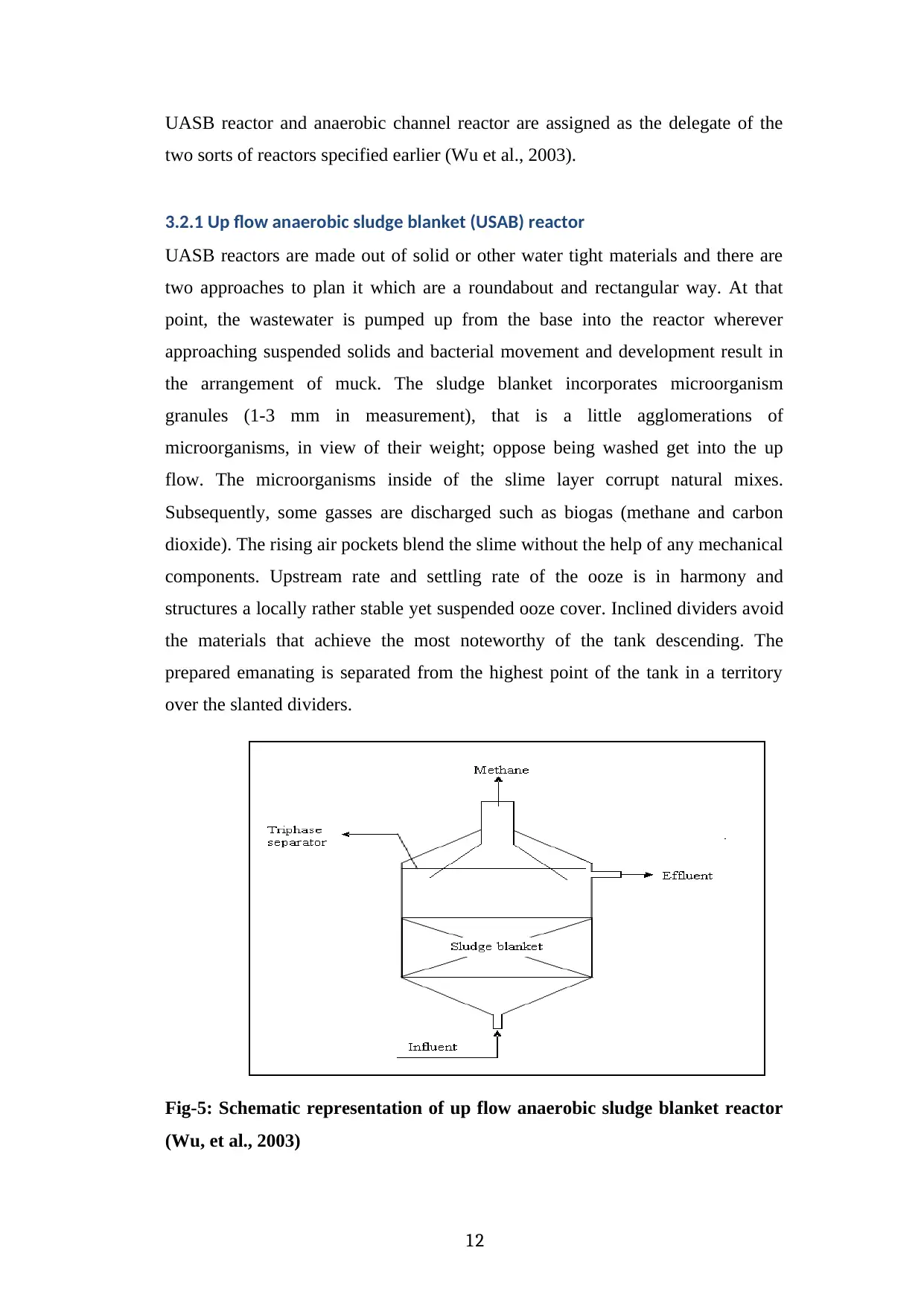
UASB reactor and anaerobic channel reactor are assigned as the delegate of the
two sorts of reactors specified earlier (Wu et al., 2003).
3.2.1 Up flow anaerobic sludge blanket (USAB) reactor
UASB reactors are made out of solid or other water tight materials and there are
two approaches to plan it which are a roundabout and rectangular way. At that
point, the wastewater is pumped up from the base into the reactor wherever
approaching suspended solids and bacterial movement and development result in
the arrangement of muck. The sludge blanket incorporates microorganism
granules (1-3 mm in measurement), that is a little agglomerations of
microorganisms, in view of their weight; oppose being washed get into the up
flow. The microorganisms inside of the slime layer corrupt natural mixes.
Subsequently, some gasses are discharged such as biogas (methane and carbon
dioxide). The rising air pockets blend the slime without the help of any mechanical
components. Upstream rate and settling rate of the ooze is in harmony and
structures a locally rather stable yet suspended ooze cover. Inclined dividers avoid
the materials that achieve the most noteworthy of the tank descending. The
prepared emanating is separated from the highest point of the tank in a territory
over the slanted dividers.
Fig-5: Schematic representation of up flow anaerobic sludge blanket reactor
(Wu, et al., 2003)
12
two sorts of reactors specified earlier (Wu et al., 2003).
3.2.1 Up flow anaerobic sludge blanket (USAB) reactor
UASB reactors are made out of solid or other water tight materials and there are
two approaches to plan it which are a roundabout and rectangular way. At that
point, the wastewater is pumped up from the base into the reactor wherever
approaching suspended solids and bacterial movement and development result in
the arrangement of muck. The sludge blanket incorporates microorganism
granules (1-3 mm in measurement), that is a little agglomerations of
microorganisms, in view of their weight; oppose being washed get into the up
flow. The microorganisms inside of the slime layer corrupt natural mixes.
Subsequently, some gasses are discharged such as biogas (methane and carbon
dioxide). The rising air pockets blend the slime without the help of any mechanical
components. Upstream rate and settling rate of the ooze is in harmony and
structures a locally rather stable yet suspended ooze cover. Inclined dividers avoid
the materials that achieve the most noteworthy of the tank descending. The
prepared emanating is separated from the highest point of the tank in a territory
over the slanted dividers.
Fig-5: Schematic representation of up flow anaerobic sludge blanket reactor
(Wu, et al., 2003)
12

A gas-liquid-solid separator (GLSS) attempts to isolate the gas from the treated
wastewater furthermore the ooze (Pedro & Walter, 2006). Following a few weeks
of utilization, a vast granules of muck are framed which, thusly, go about as
channels for littler particles in light of the fact that the emanating ascends through
the pad of ooze. In light of the up flow administration, granular-shaping living
beings are specially aggregating as the others are washed out. Luckily, this
microorganism is likewise an extra segment for biogas creation than flocculated
biomass (Fig-5)
Advantages of UASB reactor
i. The diminishment of BOD is to a great degree high.
ii. It can withstand high natural and water powered stacking rates.
iii. The ooze creation is amazingly low (and in this manner occasional
desludging is required).
iv. Biogas can be utilized for vitality (however ordinarily first it needs
scouring).
v. The air circulation framework is not required (consequently little vitality
utilization).
vi. Effluent is rich in supplements and can be utilized for farming watering
system.
vii. Lowland interest can be developed underground and with locally
accessible material.
viii. The discharge of methane and carbon dioxide is too low (Kashiwaya &
Yoshimoto. 1980)
Disadvantages of UASB reactor
i. Treatment may be shaky with variable pressure driven and natural masses.
ii. It should be worked and kept up by talented staff; hard to keep up
legitimate water driven conditions (up flow and settling rates ought to be
adjusted).
iii. Long start-up time to figure at full limit.
iv. It needs a consistent wellspring of power.
v. It is elusive all parts and materials locally.
vi. It needs learned configuration and development.
13
wastewater furthermore the ooze (Pedro & Walter, 2006). Following a few weeks
of utilization, a vast granules of muck are framed which, thusly, go about as
channels for littler particles in light of the fact that the emanating ascends through
the pad of ooze. In light of the up flow administration, granular-shaping living
beings are specially aggregating as the others are washed out. Luckily, this
microorganism is likewise an extra segment for biogas creation than flocculated
biomass (Fig-5)
Advantages of UASB reactor
i. The diminishment of BOD is to a great degree high.
ii. It can withstand high natural and water powered stacking rates.
iii. The ooze creation is amazingly low (and in this manner occasional
desludging is required).
iv. Biogas can be utilized for vitality (however ordinarily first it needs
scouring).
v. The air circulation framework is not required (consequently little vitality
utilization).
vi. Effluent is rich in supplements and can be utilized for farming watering
system.
vii. Lowland interest can be developed underground and with locally
accessible material.
viii. The discharge of methane and carbon dioxide is too low (Kashiwaya &
Yoshimoto. 1980)
Disadvantages of UASB reactor
i. Treatment may be shaky with variable pressure driven and natural masses.
ii. It should be worked and kept up by talented staff; hard to keep up
legitimate water driven conditions (up flow and settling rates ought to be
adjusted).
iii. Long start-up time to figure at full limit.
iv. It needs a consistent wellspring of power.
v. It is elusive all parts and materials locally.
vi. It needs learned configuration and development.
13
Secure Best Marks with AI Grader
Need help grading? Try our AI Grader for instant feedback on your assignments.
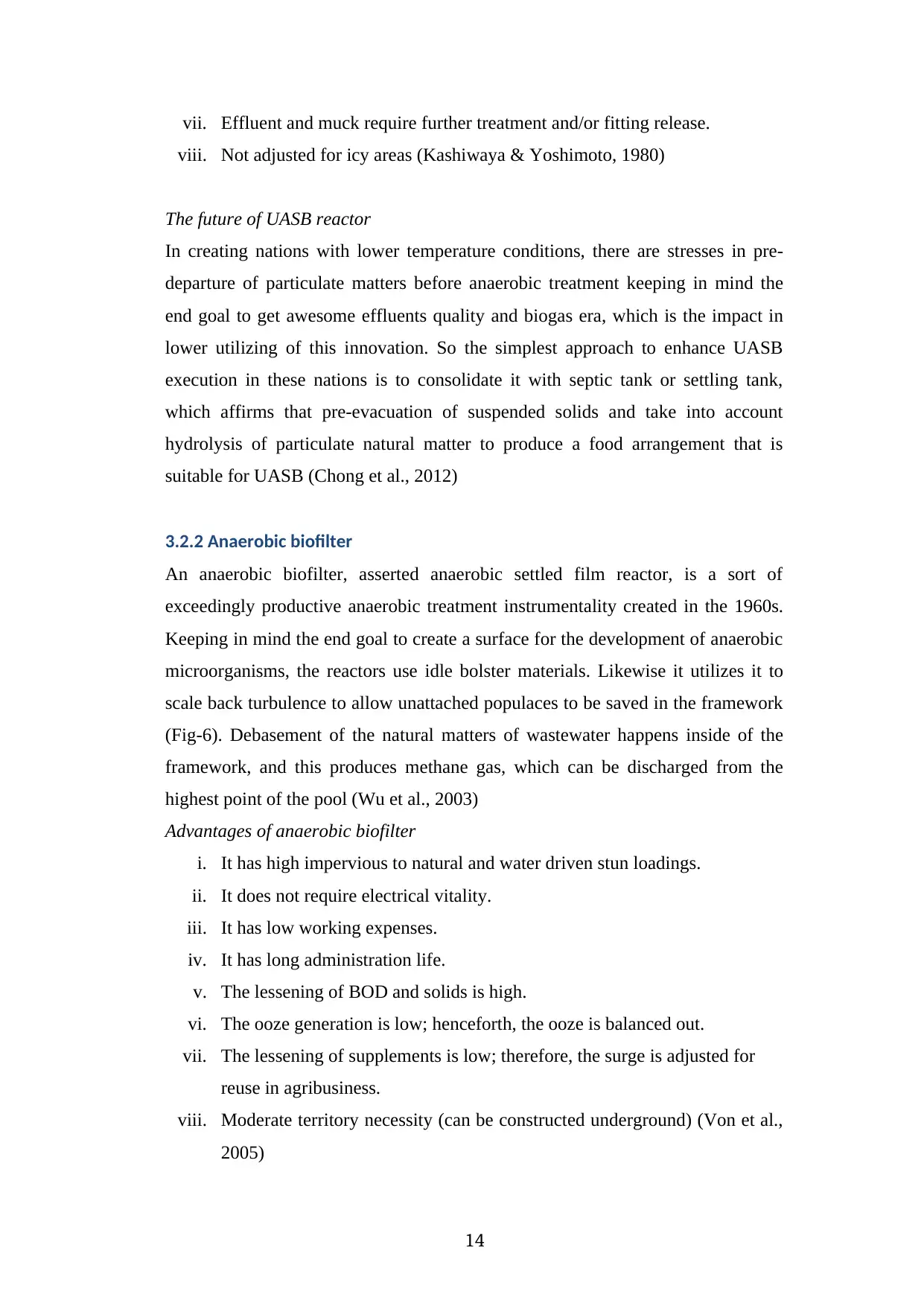
vii. Effluent and muck require further treatment and/or fitting release.
viii. Not adjusted for icy areas (Kashiwaya & Yoshimoto, 1980)
The future of UASB reactor
In creating nations with lower temperature conditions, there are stresses in pre-
departure of particulate matters before anaerobic treatment keeping in mind the
end goal to get awesome effluents quality and biogas era, which is the impact in
lower utilizing of this innovation. So the simplest approach to enhance UASB
execution in these nations is to consolidate it with septic tank or settling tank,
which affirms that pre-evacuation of suspended solids and take into account
hydrolysis of particulate natural matter to produce a food arrangement that is
suitable for UASB (Chong et al., 2012)
3.2.2 Anaerobic biofilter
An anaerobic biofilter, asserted anaerobic settled film reactor, is a sort of
exceedingly productive anaerobic treatment instrumentality created in the 1960s.
Keeping in mind the end goal to create a surface for the development of anaerobic
microorganisms, the reactors use idle bolster materials. Likewise it utilizes it to
scale back turbulence to allow unattached populaces to be saved in the framework
(Fig-6). Debasement of the natural matters of wastewater happens inside of the
framework, and this produces methane gas, which can be discharged from the
highest point of the pool (Wu et al., 2003)
Advantages of anaerobic biofilter
i. It has high impervious to natural and water driven stun loadings.
ii. It does not require electrical vitality.
iii. It has low working expenses.
iv. It has long administration life.
v. The lessening of BOD and solids is high.
vi. The ooze generation is low; henceforth, the ooze is balanced out.
vii. The lessening of supplements is low; therefore, the surge is adjusted for
reuse in agribusiness.
viii. Moderate territory necessity (can be constructed underground) (Von et al.,
2005)
14
viii. Not adjusted for icy areas (Kashiwaya & Yoshimoto, 1980)
The future of UASB reactor
In creating nations with lower temperature conditions, there are stresses in pre-
departure of particulate matters before anaerobic treatment keeping in mind the
end goal to get awesome effluents quality and biogas era, which is the impact in
lower utilizing of this innovation. So the simplest approach to enhance UASB
execution in these nations is to consolidate it with septic tank or settling tank,
which affirms that pre-evacuation of suspended solids and take into account
hydrolysis of particulate natural matter to produce a food arrangement that is
suitable for UASB (Chong et al., 2012)
3.2.2 Anaerobic biofilter
An anaerobic biofilter, asserted anaerobic settled film reactor, is a sort of
exceedingly productive anaerobic treatment instrumentality created in the 1960s.
Keeping in mind the end goal to create a surface for the development of anaerobic
microorganisms, the reactors use idle bolster materials. Likewise it utilizes it to
scale back turbulence to allow unattached populaces to be saved in the framework
(Fig-6). Debasement of the natural matters of wastewater happens inside of the
framework, and this produces methane gas, which can be discharged from the
highest point of the pool (Wu et al., 2003)
Advantages of anaerobic biofilter
i. It has high impervious to natural and water driven stun loadings.
ii. It does not require electrical vitality.
iii. It has low working expenses.
iv. It has long administration life.
v. The lessening of BOD and solids is high.
vi. The ooze generation is low; henceforth, the ooze is balanced out.
vii. The lessening of supplements is low; therefore, the surge is adjusted for
reuse in agribusiness.
viii. Moderate territory necessity (can be constructed underground) (Von et al.,
2005)
14

Disadvantages of anaerobic biofilter
i. Piped water is required to convey the squanders to the treatment unit.
ii. It requires a specialist to outline and for development.
iii. The lessening of pathogens and supplements is low.
iv. Effluent and slop require further treatment and/or suitable release.
v. Removing and cleaning the stopped up channel media are clumsy.
vi. It is suitable just for low-thickness lodging in regions with low water table
and is not inclined to flooding (M. von and C.A. de, 2005)
Fig-6: Schematic representation of an anaerobic biofilter (Wu et al., 2003)
The future of anaerobic biofilter
In future, can decrease the development costs by utilizing lightweight plastic off-
cuts as channel material set up of smashed rock and this diminishes the required
quality of the punctured floor chunk of the channel unit and this may serves to
simple accessibility of material locally without critical changes in execution.
(E.J.H, 1998)
3.2.3 Comparison between UASB reactor anaerobic biofilter
Both of anaerobic reactors have well proficient in wastewater treatment by
biodegradation yet anaerobic biofilter is the most astounding use when compared
with UASB reactor that on account of the hardest accessibility all parts and
material of it locally. Likewise, UASB minister is not ready to use in frosty range.
Notwithstanding, UASB reactor is friendlier environment than anaerobic biofilter.
15
i. Piped water is required to convey the squanders to the treatment unit.
ii. It requires a specialist to outline and for development.
iii. The lessening of pathogens and supplements is low.
iv. Effluent and slop require further treatment and/or suitable release.
v. Removing and cleaning the stopped up channel media are clumsy.
vi. It is suitable just for low-thickness lodging in regions with low water table
and is not inclined to flooding (M. von and C.A. de, 2005)
Fig-6: Schematic representation of an anaerobic biofilter (Wu et al., 2003)
The future of anaerobic biofilter
In future, can decrease the development costs by utilizing lightweight plastic off-
cuts as channel material set up of smashed rock and this diminishes the required
quality of the punctured floor chunk of the channel unit and this may serves to
simple accessibility of material locally without critical changes in execution.
(E.J.H, 1998)
3.2.3 Comparison between UASB reactor anaerobic biofilter
Both of anaerobic reactors have well proficient in wastewater treatment by
biodegradation yet anaerobic biofilter is the most astounding use when compared
with UASB reactor that on account of the hardest accessibility all parts and
material of it locally. Likewise, UASB minister is not ready to use in frosty range.
Notwithstanding, UASB reactor is friendlier environment than anaerobic biofilter.
15

On other hand, anaerobic biofilter has longer serves life and ease operation than
UASB reactor.
4.0. Comparison between anaerobic and aerobic wastewater
treatment
Vigorous natural procedures are ordinarily utilized as a part of the treatment of
natural wastewaters for accomplishing high level of treatment effectiveness, while
in anaerobic treatment, significant advancement has been accomplished in
anaerobic biotechnology for waste treatment in view of the idea of asset
recuperation and usage while as yet accomplishing the goal of contamination
control. Different benefits of both the medications are highlighted in Table-1, and
both the frameworks are fit for accomplishing high natural evacuation efficiency
(Yeoh. 1995)
Table-1: Comparison of aerobic and anaerobic treatment (Eisenmann, 2015)
Feature Aerobic Anaerobic
Natural evacuation
productivity
High High
Profluent quality Excellent Moderate to poor
Natural stacking rate Moderate High
Sludge production High Low
Supplement necessity High Low
Alkalinity necessity Low High for certain
industrial waste
Vitality necessity High Low to moderate
Temperature
sensitivity
Low High
Start-up time 2–4 weeks 2–4 months
Odour Less opportunity for odours Potential odour
problems
Bio energy and
nutrient recovery
No Yes
Method of treatment Total (depending on feed stock
characteristics)
Essentially pre-
treatment
16
UASB reactor.
4.0. Comparison between anaerobic and aerobic wastewater
treatment
Vigorous natural procedures are ordinarily utilized as a part of the treatment of
natural wastewaters for accomplishing high level of treatment effectiveness, while
in anaerobic treatment, significant advancement has been accomplished in
anaerobic biotechnology for waste treatment in view of the idea of asset
recuperation and usage while as yet accomplishing the goal of contamination
control. Different benefits of both the medications are highlighted in Table-1, and
both the frameworks are fit for accomplishing high natural evacuation efficiency
(Yeoh. 1995)
Table-1: Comparison of aerobic and anaerobic treatment (Eisenmann, 2015)
Feature Aerobic Anaerobic
Natural evacuation
productivity
High High
Profluent quality Excellent Moderate to poor
Natural stacking rate Moderate High
Sludge production High Low
Supplement necessity High Low
Alkalinity necessity Low High for certain
industrial waste
Vitality necessity High Low to moderate
Temperature
sensitivity
Low High
Start-up time 2–4 weeks 2–4 months
Odour Less opportunity for odours Potential odour
problems
Bio energy and
nutrient recovery
No Yes
Method of treatment Total (depending on feed stock
characteristics)
Essentially pre-
treatment
16
Paraphrase This Document
Need a fresh take? Get an instant paraphrase of this document with our AI Paraphraser
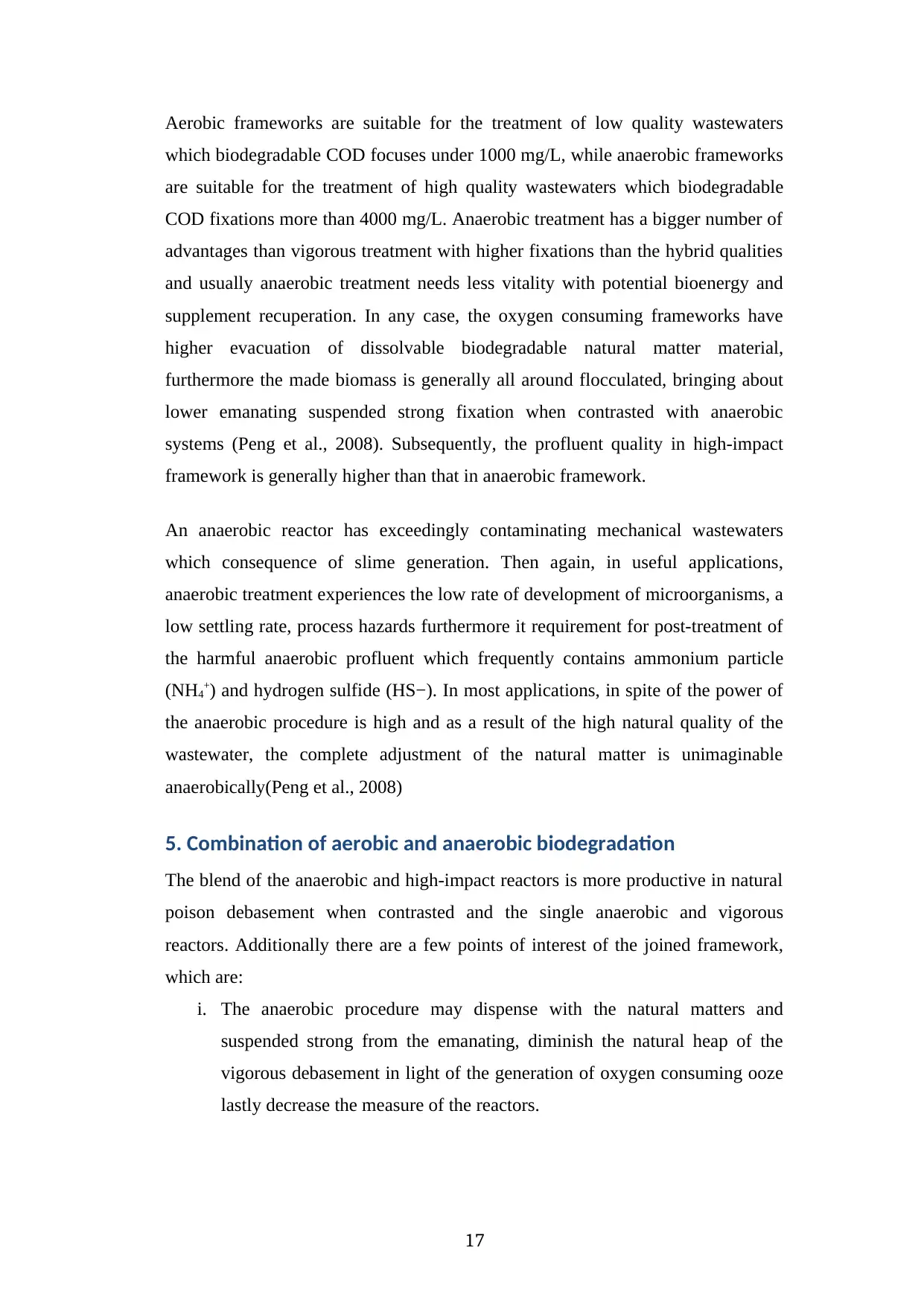
Aerobic frameworks are suitable for the treatment of low quality wastewaters
which biodegradable COD focuses under 1000 mg/L, while anaerobic frameworks
are suitable for the treatment of high quality wastewaters which biodegradable
COD fixations more than 4000 mg/L. Anaerobic treatment has a bigger number of
advantages than vigorous treatment with higher fixations than the hybrid qualities
and usually anaerobic treatment needs less vitality with potential bioenergy and
supplement recuperation. In any case, the oxygen consuming frameworks have
higher evacuation of dissolvable biodegradable natural matter material,
furthermore the made biomass is generally all around flocculated, bringing about
lower emanating suspended strong fixation when contrasted with anaerobic
systems (Peng et al., 2008). Subsequently, the profluent quality in high-impact
framework is generally higher than that in anaerobic framework.
An anaerobic reactor has exceedingly contaminating mechanical wastewaters
which consequence of slime generation. Then again, in useful applications,
anaerobic treatment experiences the low rate of development of microorganisms, a
low settling rate, process hazards furthermore it requirement for post-treatment of
the harmful anaerobic profluent which frequently contains ammonium particle
(NH4+) and hydrogen sulfide (HS−). In most applications, in spite of the power of
the anaerobic procedure is high and as a result of the high natural quality of the
wastewater, the complete adjustment of the natural matter is unimaginable
anaerobically(Peng et al., 2008)
5. Combination of aerobic and anaerobic biodegradation
The blend of the anaerobic and high-impact reactors is more productive in natural
poison debasement when contrasted and the single anaerobic and vigorous
reactors. Additionally there are a few points of interest of the joined framework,
which are:
i. The anaerobic procedure may dispense with the natural matters and
suspended strong from the emanating, diminish the natural heap of the
vigorous debasement in light of the generation of oxygen consuming ooze
lastly decrease the measure of the reactors.
17
which biodegradable COD focuses under 1000 mg/L, while anaerobic frameworks
are suitable for the treatment of high quality wastewaters which biodegradable
COD fixations more than 4000 mg/L. Anaerobic treatment has a bigger number of
advantages than vigorous treatment with higher fixations than the hybrid qualities
and usually anaerobic treatment needs less vitality with potential bioenergy and
supplement recuperation. In any case, the oxygen consuming frameworks have
higher evacuation of dissolvable biodegradable natural matter material,
furthermore the made biomass is generally all around flocculated, bringing about
lower emanating suspended strong fixation when contrasted with anaerobic
systems (Peng et al., 2008). Subsequently, the profluent quality in high-impact
framework is generally higher than that in anaerobic framework.
An anaerobic reactor has exceedingly contaminating mechanical wastewaters
which consequence of slime generation. Then again, in useful applications,
anaerobic treatment experiences the low rate of development of microorganisms, a
low settling rate, process hazards furthermore it requirement for post-treatment of
the harmful anaerobic profluent which frequently contains ammonium particle
(NH4+) and hydrogen sulfide (HS−). In most applications, in spite of the power of
the anaerobic procedure is high and as a result of the high natural quality of the
wastewater, the complete adjustment of the natural matter is unimaginable
anaerobically(Peng et al., 2008)
5. Combination of aerobic and anaerobic biodegradation
The blend of the anaerobic and high-impact reactors is more productive in natural
poison debasement when contrasted and the single anaerobic and vigorous
reactors. Additionally there are a few points of interest of the joined framework,
which are:
i. The anaerobic procedure may dispense with the natural matters and
suspended strong from the emanating, diminish the natural heap of the
vigorous debasement in light of the generation of oxygen consuming ooze
lastly decrease the measure of the reactors.
17

ii. Wastewater pre-treated by anaerobic innovation is more steady and
delegate that anaerobic procedure could diminish the heap vacillation of
the wastewater, in this way, lessening of the necessity for oxygen for the
vigorous corruption.
iii. The anaerobic procedure could change the biochemical properties of
wastewater, so that making the accompanying vigorous procedure is more
proficient.
Examination introduced that wastewater from aerobic–anaerobic consolidated
reactor is more steady and is prepared for debasement, implying that this method
has a gigantic potential for application. The excellent aerobic–anaerobic reactors
incorporate oxidation dump and built wetland (Leslie et al., 1999)
5.1 Oxidation ditch
The oxidation trench is a roundabout bowl through which the wastewater streams.
The enacted muck is added to the oxidation trench so that the microorganisms will
process the natural poisons in water. This blend of crude wastewater and returned
muck is known as blended alcohol. The pivoting organic contactors could add
oxygen into the streaming blended alcohol, which will furthermore build spread
and make waves and development inside of the trench. At the point when the
natural pollutants have been expelled from the wastewater, the blended alcohol
streams out of the oxidation trench. At that point, the muck is evacuated in the
auxiliary settling tank, and some portion of the slop is pumped to an ooze pumping
room where the slime is thickened with the offer of aerator some assistance with
pumping. A portion of the ooze is come back to the oxidation trench while
whatever remains of the slime is sent to waste (Peng et al., 2008)
The oxidation trench is delineated by simple procedure. It has low support and
utilization, enduring operation and solid stun resistance. The profluent of the
framework has superb water gushing with low convergence of natural
contaminations, nitrogen and phosphorus. However, certain restrictions are
considered to be important include (i) sludge expansion and (ii) rising sludge and
foam (Fig-7).
18
delegate that anaerobic procedure could diminish the heap vacillation of
the wastewater, in this way, lessening of the necessity for oxygen for the
vigorous corruption.
iii. The anaerobic procedure could change the biochemical properties of
wastewater, so that making the accompanying vigorous procedure is more
proficient.
Examination introduced that wastewater from aerobic–anaerobic consolidated
reactor is more steady and is prepared for debasement, implying that this method
has a gigantic potential for application. The excellent aerobic–anaerobic reactors
incorporate oxidation dump and built wetland (Leslie et al., 1999)
5.1 Oxidation ditch
The oxidation trench is a roundabout bowl through which the wastewater streams.
The enacted muck is added to the oxidation trench so that the microorganisms will
process the natural poisons in water. This blend of crude wastewater and returned
muck is known as blended alcohol. The pivoting organic contactors could add
oxygen into the streaming blended alcohol, which will furthermore build spread
and make waves and development inside of the trench. At the point when the
natural pollutants have been expelled from the wastewater, the blended alcohol
streams out of the oxidation trench. At that point, the muck is evacuated in the
auxiliary settling tank, and some portion of the slop is pumped to an ooze pumping
room where the slime is thickened with the offer of aerator some assistance with
pumping. A portion of the ooze is come back to the oxidation trench while
whatever remains of the slime is sent to waste (Peng et al., 2008)
The oxidation trench is delineated by simple procedure. It has low support and
utilization, enduring operation and solid stun resistance. The profluent of the
framework has superb water gushing with low convergence of natural
contaminations, nitrogen and phosphorus. However, certain restrictions are
considered to be important include (i) sludge expansion and (ii) rising sludge and
foam (Fig-7).
18

Fig-7: Schematic representation of the oxidation ditch (Peng et al., 2008)
Advantages of oxidation ditch
i. It has capacity to achieve evacuation execution objects with low
operational prerequisites and support costs.
ii. Long water driven maintenance time, which minimize the effect of a stun
load.
iii. Less slop creation than another natural treatment procedures and that
motivation to delayed organic movement amid the initiated slime process.
iv. Less vitality costs when contrasted and other natural treatment forms
(EPA, 2002)
Disadvantages of oxidation trench
i. Huge of emanating suspended solids fixations.
ii. A extensive area range is required (EPA, 2002)
5.2 Constructed wet land
A built wetland is a manufactured wetland that could go about as a biofilter. It
attempts to uproot residue and contaminations, for example, overwhelming metals
and natural toxins from water. Developed wetland is a mix of water, media, plants,
19
Advantages of oxidation ditch
i. It has capacity to achieve evacuation execution objects with low
operational prerequisites and support costs.
ii. Long water driven maintenance time, which minimize the effect of a stun
load.
iii. Less slop creation than another natural treatment procedures and that
motivation to delayed organic movement amid the initiated slime process.
iv. Less vitality costs when contrasted and other natural treatment forms
(EPA, 2002)
Disadvantages of oxidation trench
i. Huge of emanating suspended solids fixations.
ii. A extensive area range is required (EPA, 2002)
5.2 Constructed wet land
A built wetland is a manufactured wetland that could go about as a biofilter. It
attempts to uproot residue and contaminations, for example, overwhelming metals
and natural toxins from water. Developed wetland is a mix of water, media, plants,
19
Secure Best Marks with AI Grader
Need help grading? Try our AI Grader for instant feedback on your assignments.
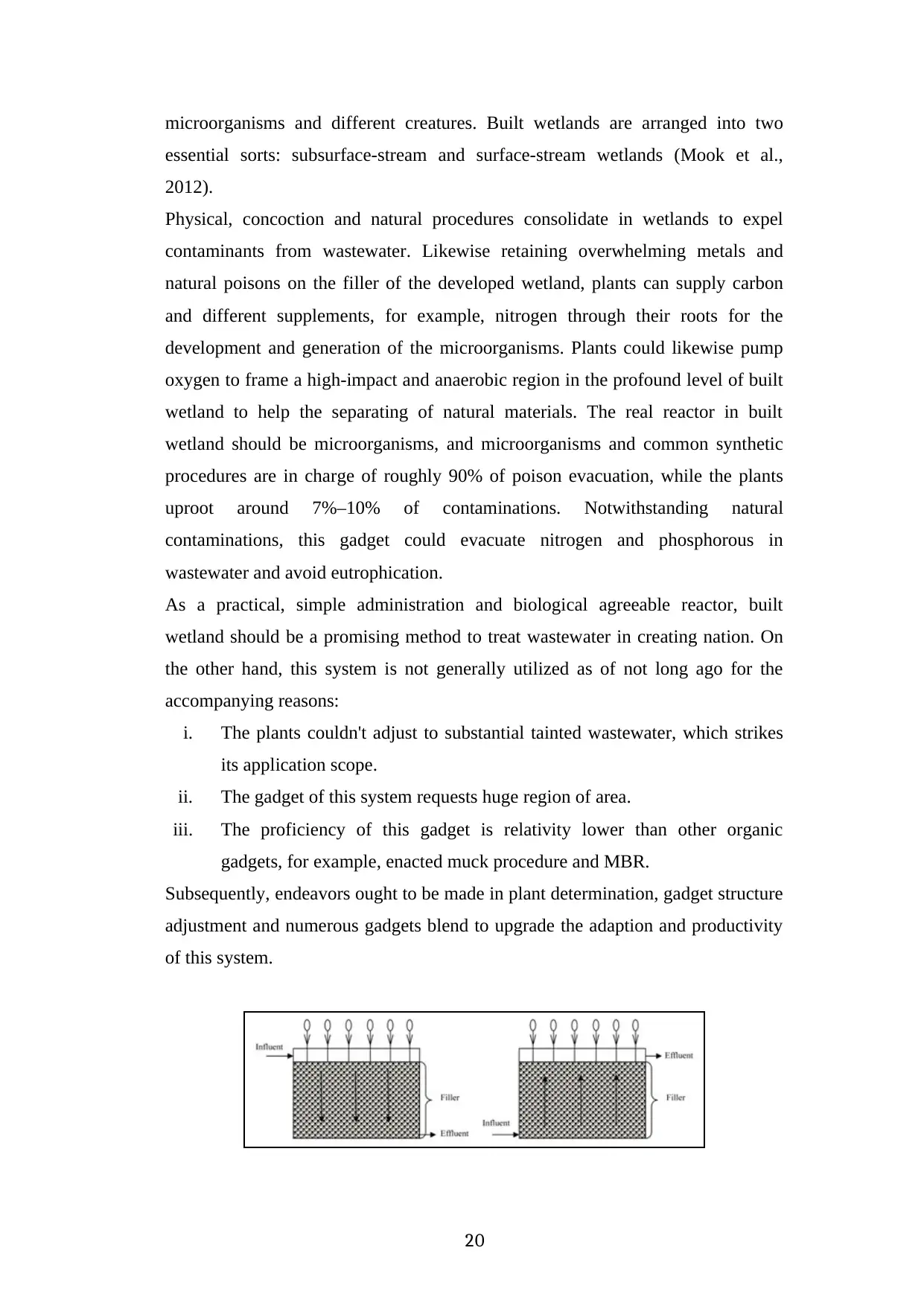
microorganisms and different creatures. Built wetlands are arranged into two
essential sorts: subsurface-stream and surface-stream wetlands (Mook et al.,
2012).
Physical, concoction and natural procedures consolidate in wetlands to expel
contaminants from wastewater. Likewise retaining overwhelming metals and
natural poisons on the filler of the developed wetland, plants can supply carbon
and different supplements, for example, nitrogen through their roots for the
development and generation of the microorganisms. Plants could likewise pump
oxygen to frame a high-impact and anaerobic region in the profound level of built
wetland to help the separating of natural materials. The real reactor in built
wetland should be microorganisms, and microorganisms and common synthetic
procedures are in charge of roughly 90% of poison evacuation, while the plants
uproot around 7%–10% of contaminations. Notwithstanding natural
contaminations, this gadget could evacuate nitrogen and phosphorous in
wastewater and avoid eutrophication.
As a practical, simple administration and biological agreeable reactor, built
wetland should be a promising method to treat wastewater in creating nation. On
the other hand, this system is not generally utilized as of not long ago for the
accompanying reasons:
i. The plants couldn't adjust to substantial tainted wastewater, which strikes
its application scope.
ii. The gadget of this system requests huge region of area.
iii. The proficiency of this gadget is relativity lower than other organic
gadgets, for example, enacted muck procedure and MBR.
Subsequently, endeavors ought to be made in plant determination, gadget structure
adjustment and numerous gadgets blend to upgrade the adaption and productivity
of this system.
20
essential sorts: subsurface-stream and surface-stream wetlands (Mook et al.,
2012).
Physical, concoction and natural procedures consolidate in wetlands to expel
contaminants from wastewater. Likewise retaining overwhelming metals and
natural poisons on the filler of the developed wetland, plants can supply carbon
and different supplements, for example, nitrogen through their roots for the
development and generation of the microorganisms. Plants could likewise pump
oxygen to frame a high-impact and anaerobic region in the profound level of built
wetland to help the separating of natural materials. The real reactor in built
wetland should be microorganisms, and microorganisms and common synthetic
procedures are in charge of roughly 90% of poison evacuation, while the plants
uproot around 7%–10% of contaminations. Notwithstanding natural
contaminations, this gadget could evacuate nitrogen and phosphorous in
wastewater and avoid eutrophication.
As a practical, simple administration and biological agreeable reactor, built
wetland should be a promising method to treat wastewater in creating nation. On
the other hand, this system is not generally utilized as of not long ago for the
accompanying reasons:
i. The plants couldn't adjust to substantial tainted wastewater, which strikes
its application scope.
ii. The gadget of this system requests huge region of area.
iii. The proficiency of this gadget is relativity lower than other organic
gadgets, for example, enacted muck procedure and MBR.
Subsequently, endeavors ought to be made in plant determination, gadget structure
adjustment and numerous gadgets blend to upgrade the adaption and productivity
of this system.
20

Fig-8: Schematic representation of the subsurface stream developed wetland
of diverse sustaining pattern (EPA, 2002)
The quickening industrialization in creating nations with a colossal utilization of
metals constitutes an ecological sullying peril. The utilization of wetlands for
modern wastewater treatment is a promising option. What's more, wetlands have
critical benefits of low capital and working expenses contrast and ordinary
framework as initiated ooze, circulated air through tidal pond framework et cetera.
Advantages of built wetland
i. Low expense expected to build and work is not costly.
ii. High effectiveness and naturally benevolent treatment.
iii. It can be delightfully satisfying and they additionally give environment to
natural life and human happiness (Ekby, 2002).
Disadvantages of built wetlands
i. Large area region is required.
ii. Long time is required for treatment which may bring about issues with
bugs (Ekby,2002)
6.0. Wellbeing contemplations for natural procedures for
mechanical wastewater
Anaerobic–aerobic medicines have awesome consideration over the past periods
due to their shifted advantages, for example, low vitality utilization, low substance
utilization, low slime creation, inconceivable capability of asset recuperation, less
hardware required and high operational straightforwardness. As the emanating
created has an excellent yet regardless it represents a wellbeing danger. In this
way, maintain a strategic distance from any took care of straightforwardly
however experience a proper fumigation treatment before discharge (e.g. UV-
light, chlorination). The peril human and ecological wellbeing could happen if
there are no keep up the framework. Likewise, this prompted hinder the
wastewater framework and to minimize this danger, profoundly prepared stuff is
requirement for support and investigating. The mechanical hardware, for example,
blenders, aerators and pumps must be always kept up. For human wellbeing, the
21
of diverse sustaining pattern (EPA, 2002)
The quickening industrialization in creating nations with a colossal utilization of
metals constitutes an ecological sullying peril. The utilization of wetlands for
modern wastewater treatment is a promising option. What's more, wetlands have
critical benefits of low capital and working expenses contrast and ordinary
framework as initiated ooze, circulated air through tidal pond framework et cetera.
Advantages of built wetland
i. Low expense expected to build and work is not costly.
ii. High effectiveness and naturally benevolent treatment.
iii. It can be delightfully satisfying and they additionally give environment to
natural life and human happiness (Ekby, 2002).
Disadvantages of built wetlands
i. Large area region is required.
ii. Long time is required for treatment which may bring about issues with
bugs (Ekby,2002)
6.0. Wellbeing contemplations for natural procedures for
mechanical wastewater
Anaerobic–aerobic medicines have awesome consideration over the past periods
due to their shifted advantages, for example, low vitality utilization, low substance
utilization, low slime creation, inconceivable capability of asset recuperation, less
hardware required and high operational straightforwardness. As the emanating
created has an excellent yet regardless it represents a wellbeing danger. In this
way, maintain a strategic distance from any took care of straightforwardly
however experience a proper fumigation treatment before discharge (e.g. UV-
light, chlorination). The peril human and ecological wellbeing could happen if
there are no keep up the framework. Likewise, this prompted hinder the
wastewater framework and to minimize this danger, profoundly prepared stuff is
requirement for support and investigating. The mechanical hardware, for example,
blenders, aerators and pumps must be always kept up. For human wellbeing, the
21
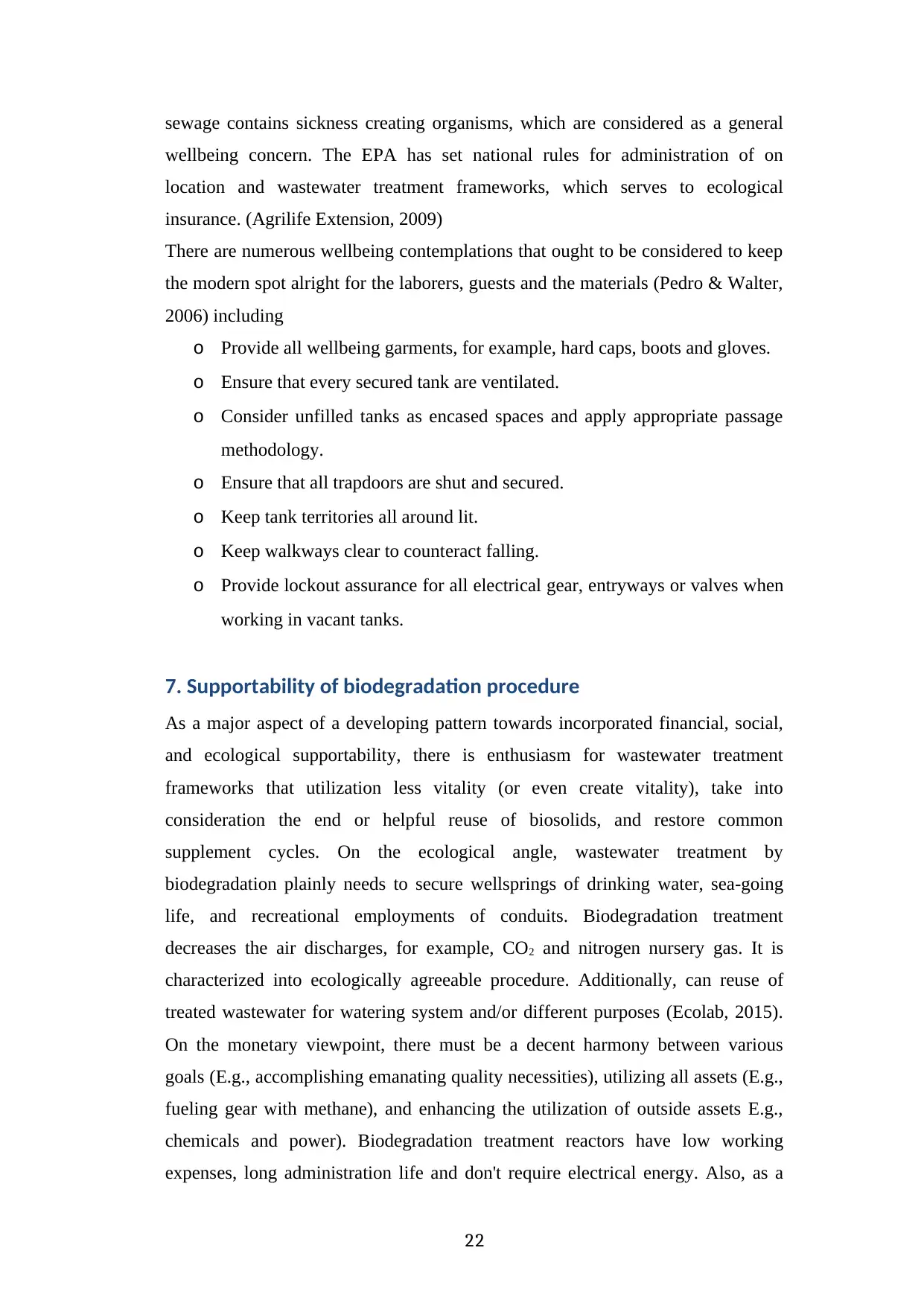
sewage contains sickness creating organisms, which are considered as a general
wellbeing concern. The EPA has set national rules for administration of on
location and wastewater treatment frameworks, which serves to ecological
insurance. (Agrilife Extension, 2009)
There are numerous wellbeing contemplations that ought to be considered to keep
the modern spot alright for the laborers, guests and the materials (Pedro & Walter,
2006) including
o Provide all wellbeing garments, for example, hard caps, boots and gloves.
o Ensure that every secured tank are ventilated.
o Consider unfilled tanks as encased spaces and apply appropriate passage
methodology.
o Ensure that all trapdoors are shut and secured.
o Keep tank territories all around lit.
o Keep walkways clear to counteract falling.
o Provide lockout assurance for all electrical gear, entryways or valves when
working in vacant tanks.
7. Supportability of biodegradation procedure
As a major aspect of a developing pattern towards incorporated financial, social,
and ecological supportability, there is enthusiasm for wastewater treatment
frameworks that utilization less vitality (or even create vitality), take into
consideration the end or helpful reuse of biosolids, and restore common
supplement cycles. On the ecological angle, wastewater treatment by
biodegradation plainly needs to secure wellsprings of drinking water, sea-going
life, and recreational employments of conduits. Biodegradation treatment
decreases the air discharges, for example, CO2 and nitrogen nursery gas. It is
characterized into ecologically agreeable procedure. Additionally, can reuse of
treated wastewater for watering system and/or different purposes (Ecolab, 2015).
On the monetary viewpoint, there must be a decent harmony between various
goals (E.g., accomplishing emanating quality necessities), utilizing all assets (E.g.,
fueling gear with methane), and enhancing the utilization of outside assets E.g.,
chemicals and power). Biodegradation treatment reactors have low working
expenses, long administration life and don't require electrical energy. Also, as a
22
wellbeing concern. The EPA has set national rules for administration of on
location and wastewater treatment frameworks, which serves to ecological
insurance. (Agrilife Extension, 2009)
There are numerous wellbeing contemplations that ought to be considered to keep
the modern spot alright for the laborers, guests and the materials (Pedro & Walter,
2006) including
o Provide all wellbeing garments, for example, hard caps, boots and gloves.
o Ensure that every secured tank are ventilated.
o Consider unfilled tanks as encased spaces and apply appropriate passage
methodology.
o Ensure that all trapdoors are shut and secured.
o Keep tank territories all around lit.
o Keep walkways clear to counteract falling.
o Provide lockout assurance for all electrical gear, entryways or valves when
working in vacant tanks.
7. Supportability of biodegradation procedure
As a major aspect of a developing pattern towards incorporated financial, social,
and ecological supportability, there is enthusiasm for wastewater treatment
frameworks that utilization less vitality (or even create vitality), take into
consideration the end or helpful reuse of biosolids, and restore common
supplement cycles. On the ecological angle, wastewater treatment by
biodegradation plainly needs to secure wellsprings of drinking water, sea-going
life, and recreational employments of conduits. Biodegradation treatment
decreases the air discharges, for example, CO2 and nitrogen nursery gas. It is
characterized into ecologically agreeable procedure. Additionally, can reuse of
treated wastewater for watering system and/or different purposes (Ecolab, 2015).
On the monetary viewpoint, there must be a decent harmony between various
goals (E.g., accomplishing emanating quality necessities), utilizing all assets (E.g.,
fueling gear with methane), and enhancing the utilization of outside assets E.g.,
chemicals and power). Biodegradation treatment reactors have low working
expenses, long administration life and don't require electrical energy. Also, as a
22
Paraphrase This Document
Need a fresh take? Get an instant paraphrase of this document with our AI Paraphraser

Biodegradation treatment makes some vitality, it could reuse it and used to work
the machine of mechanical.
On social supportability angle, the modern of wastewater treatment will give
numerous work opportunities; along these lines will lessen the unemployment
problems (Werf, 2012)
8. Conclusions
The natural treatment is one of the imperative and necessary parts of any
wastewater treatment plant that treats wastewater from rural and urban regions.
The treatment technologies for organic wastewater at present were reviewed. A
variety of technologies such as biological treatment, chemical oxidation
technologies, adsorption technology and the others were introduced. Organic
treatment is the best strategy in wastewater treatment working expenses when
contrasted and compound oxidation and warm oxidation. Natural treatment can
create cleaner effluents at a lower expense than different procedures. There are
two sorts of biodegradation procedure, which are oxygen consuming and
anaerobic procedures. The distinction between these two procedures is in the
vicinity of oxygen (vigorous) and without oxygen (anaerobic).There are two
unique reactors that are utilized as a part of aerobic process, CAS and MBR. In
examination with these two reactors, the MBR has higher wastewater productivity
and fewer zones required for building than CAS. Additionally, anaerobic
procedure has two unique reactors, which are UASB and anaerobic biofilter. Both
vigorous and anaerobic procedures have high natural evacuation proficiency, yet
the anaerobic procedure has lower slime generation and supplement prerequisite
than high-impact process. Keeping in mind the end goal to make more effective
natural contamination corruption, the blend of the anaerobic and oxygen
consuming reactors is more helpful when contrasted and the single anaerobic and
vigorous reactors. The joined anaerobic/oxygen consuming procedure was
effectively used to treat saline wastewater for supplement (COD, N, P) evacuation.
There are to excellent of incorporated treatment process, which are oxidation
jettison and built wetland. Furthermore, built wetlands have more successful and
ease and it could be an efficient alternative for optional treatment. The entire
23
the machine of mechanical.
On social supportability angle, the modern of wastewater treatment will give
numerous work opportunities; along these lines will lessen the unemployment
problems (Werf, 2012)
8. Conclusions
The natural treatment is one of the imperative and necessary parts of any
wastewater treatment plant that treats wastewater from rural and urban regions.
The treatment technologies for organic wastewater at present were reviewed. A
variety of technologies such as biological treatment, chemical oxidation
technologies, adsorption technology and the others were introduced. Organic
treatment is the best strategy in wastewater treatment working expenses when
contrasted and compound oxidation and warm oxidation. Natural treatment can
create cleaner effluents at a lower expense than different procedures. There are
two sorts of biodegradation procedure, which are oxygen consuming and
anaerobic procedures. The distinction between these two procedures is in the
vicinity of oxygen (vigorous) and without oxygen (anaerobic).There are two
unique reactors that are utilized as a part of aerobic process, CAS and MBR. In
examination with these two reactors, the MBR has higher wastewater productivity
and fewer zones required for building than CAS. Additionally, anaerobic
procedure has two unique reactors, which are UASB and anaerobic biofilter. Both
vigorous and anaerobic procedures have high natural evacuation proficiency, yet
the anaerobic procedure has lower slime generation and supplement prerequisite
than high-impact process. Keeping in mind the end goal to make more effective
natural contamination corruption, the blend of the anaerobic and oxygen
consuming reactors is more helpful when contrasted and the single anaerobic and
vigorous reactors. The joined anaerobic/oxygen consuming procedure was
effectively used to treat saline wastewater for supplement (COD, N, P) evacuation.
There are to excellent of incorporated treatment process, which are oxidation
jettison and built wetland. Furthermore, built wetlands have more successful and
ease and it could be an efficient alternative for optional treatment. The entire
23
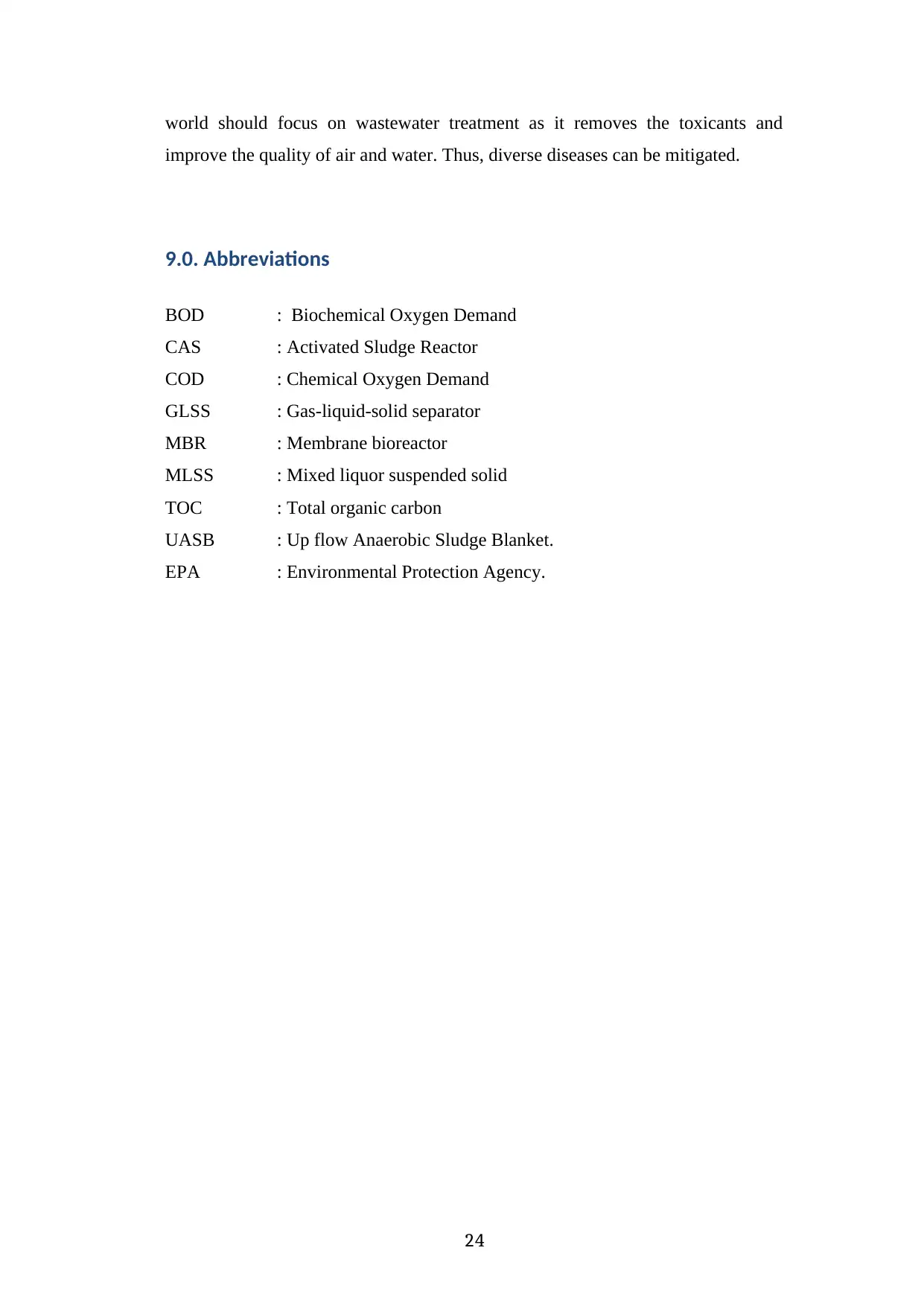
world should focus on wastewater treatment as it removes the toxicants and
improve the quality of air and water. Thus, diverse diseases can be mitigated.
9.0. Abbreviations
BOD : Biochemical Oxygen Demand
CAS : Activated Sludge Reactor
COD : Chemical Oxygen Demand
GLSS : Gas-liquid-solid separator
MBR : Membrane bioreactor
MLSS : Mixed liquor suspended solid
TOC : Total organic carbon
UASB : Up flow Anaerobic Sludge Blanket.
EPA : Environmental Protection Agency.
24
improve the quality of air and water. Thus, diverse diseases can be mitigated.
9.0. Abbreviations
BOD : Biochemical Oxygen Demand
CAS : Activated Sludge Reactor
COD : Chemical Oxygen Demand
GLSS : Gas-liquid-solid separator
MBR : Membrane bioreactor
MLSS : Mixed liquor suspended solid
TOC : Total organic carbon
UASB : Up flow Anaerobic Sludge Blanket.
EPA : Environmental Protection Agency.
24
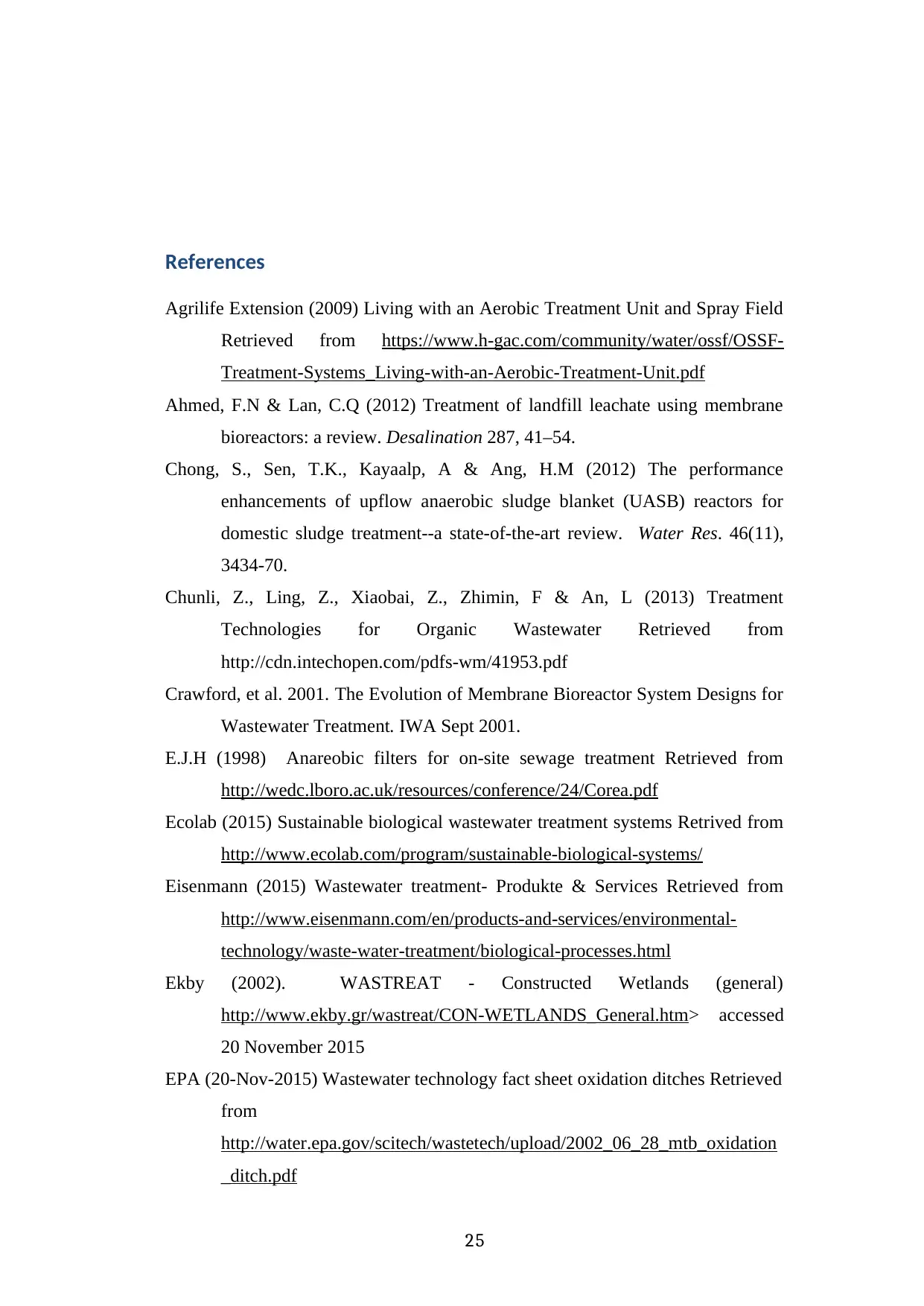
References
Agrilife Extension (2009) Living with an Aerobic Treatment Unit and Spray Field
Retrieved from https://www.h-gac.com/community/water/ossf/OSSF-
Treatment-Systems_Living-with-an-Aerobic-Treatment-Unit.pdf
Ahmed, F.N & Lan, C.Q (2012) Treatment of landfill leachate using membrane
bioreactors: a review. Desalination 287, 41–54.
Chong, S., Sen, T.K., Kayaalp, A & Ang, H.M (2012) The performance
enhancements of upflow anaerobic sludge blanket (UASB) reactors for
domestic sludge treatment--a state-of-the-art review. Water Res. 46(11),
3434-70.
Chunli, Z., Ling, Z., Xiaobai, Z., Zhimin, F & An, L (2013) Treatment
Technologies for Organic Wastewater Retrieved from
http://cdn.intechopen.com/pdfs-wm/41953.pdf
Crawford, et al. 2001. The Evolution of Membrane Bioreactor System Designs for
Wastewater Treatment. IWA Sept 2001.
E.J.H (1998) Anareobic filters for on-site sewage treatment Retrieved from
http://wedc.lboro.ac.uk/resources/conference/24/Corea.pdf
Ecolab (2015) Sustainable biological wastewater treatment systems Retrived from
http://www.ecolab.com/program/sustainable-biological-systems/
Eisenmann (2015) Wastewater treatment- Produkte & Services Retrieved from
http://www.eisenmann.com/en/products-and-services/environmental-
technology/waste-water-treatment/biological-processes.html
Ekby (2002). WASTREAT - Constructed Wetlands (general)
http://www.ekby.gr/wastreat/CON-WETLANDS_General.htm> accessed
20 November 2015
EPA (20-Nov-2015) Wastewater technology fact sheet oxidation ditches Retrieved
from
http://water.epa.gov/scitech/wastetech/upload/2002_06_28_mtb_oxidation
_ditch.pdf
25
Agrilife Extension (2009) Living with an Aerobic Treatment Unit and Spray Field
Retrieved from https://www.h-gac.com/community/water/ossf/OSSF-
Treatment-Systems_Living-with-an-Aerobic-Treatment-Unit.pdf
Ahmed, F.N & Lan, C.Q (2012) Treatment of landfill leachate using membrane
bioreactors: a review. Desalination 287, 41–54.
Chong, S., Sen, T.K., Kayaalp, A & Ang, H.M (2012) The performance
enhancements of upflow anaerobic sludge blanket (UASB) reactors for
domestic sludge treatment--a state-of-the-art review. Water Res. 46(11),
3434-70.
Chunli, Z., Ling, Z., Xiaobai, Z., Zhimin, F & An, L (2013) Treatment
Technologies for Organic Wastewater Retrieved from
http://cdn.intechopen.com/pdfs-wm/41953.pdf
Crawford, et al. 2001. The Evolution of Membrane Bioreactor System Designs for
Wastewater Treatment. IWA Sept 2001.
E.J.H (1998) Anareobic filters for on-site sewage treatment Retrieved from
http://wedc.lboro.ac.uk/resources/conference/24/Corea.pdf
Ecolab (2015) Sustainable biological wastewater treatment systems Retrived from
http://www.ecolab.com/program/sustainable-biological-systems/
Eisenmann (2015) Wastewater treatment- Produkte & Services Retrieved from
http://www.eisenmann.com/en/products-and-services/environmental-
technology/waste-water-treatment/biological-processes.html
Ekby (2002). WASTREAT - Constructed Wetlands (general)
http://www.ekby.gr/wastreat/CON-WETLANDS_General.htm> accessed
20 November 2015
EPA (20-Nov-2015) Wastewater technology fact sheet oxidation ditches Retrieved
from
http://water.epa.gov/scitech/wastetech/upload/2002_06_28_mtb_oxidation
_ditch.pdf
25
Secure Best Marks with AI Grader
Need help grading? Try our AI Grader for instant feedback on your assignments.
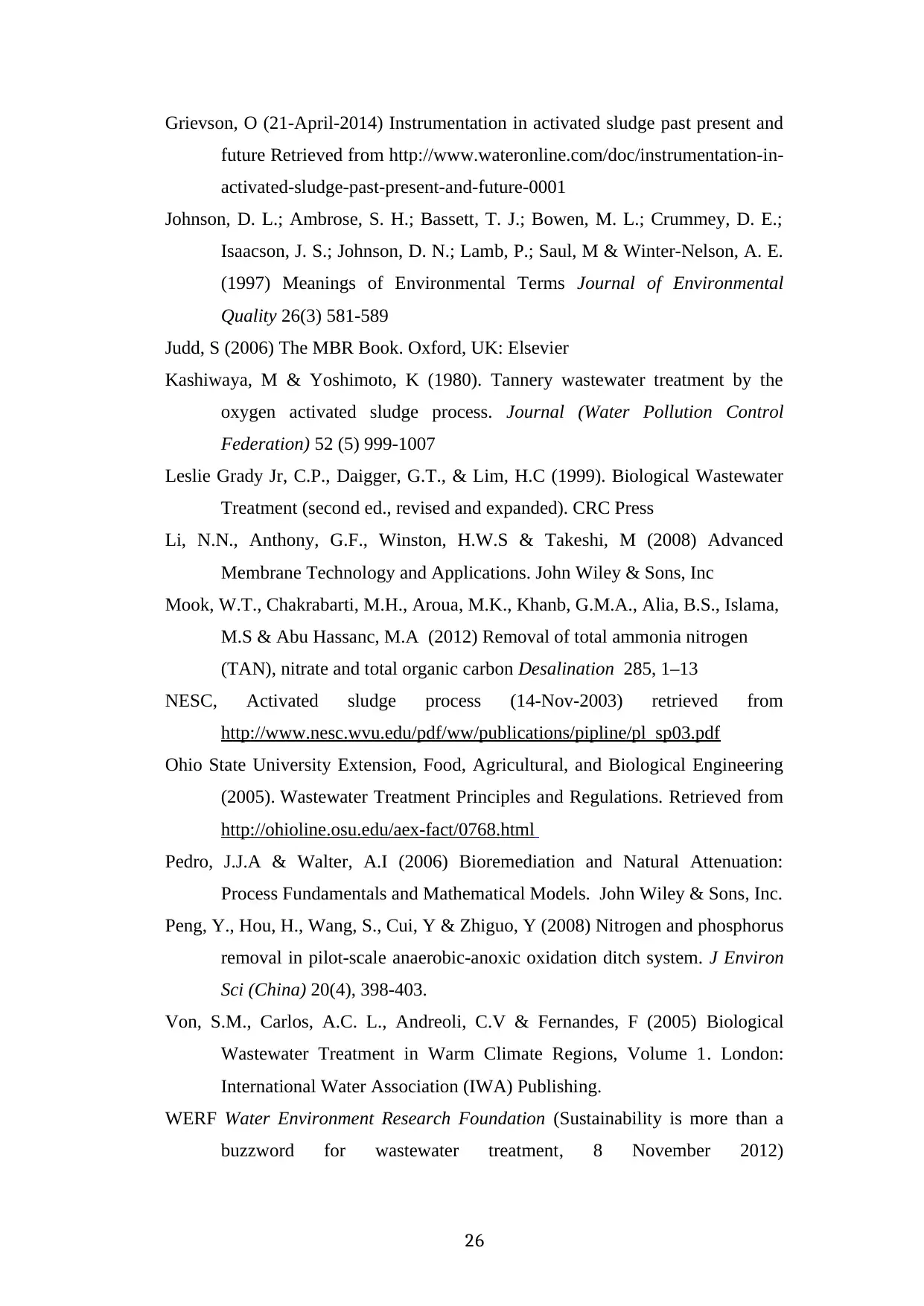
Grievson, O (21-April-2014) Instrumentation in activated sludge past present and
future Retrieved from http://www.wateronline.com/doc/instrumentation-in-
activated-sludge-past-present-and-future-0001
Johnson, D. L.; Ambrose, S. H.; Bassett, T. J.; Bowen, M. L.; Crummey, D. E.;
Isaacson, J. S.; Johnson, D. N.; Lamb, P.; Saul, M & Winter-Nelson, A. E.
(1997) Meanings of Environmental Terms Journal of Environmental
Quality 26(3) 581-589
Judd, S (2006) The MBR Book. Oxford, UK: Elsevier
Kashiwaya, M & Yoshimoto, K (1980). Tannery wastewater treatment by the
oxygen activated sludge process. Journal (Water Pollution Control
Federation) 52 (5) 999-1007
Leslie Grady Jr, C.P., Daigger, G.T., & Lim, H.C (1999). Biological Wastewater
Treatment (second ed., revised and expanded). CRC Press
Li, N.N., Anthony, G.F., Winston, H.W.S & Takeshi, M (2008) Advanced
Membrane Technology and Applications. John Wiley & Sons, Inc
Mook, W.T., Chakrabarti, M.H., Aroua, M.K., Khanb, G.M.A., Alia, B.S., Islama,
M.S & Abu Hassanc, M.A (2012) Removal of total ammonia nitrogen
(TAN), nitrate and total organic carbon Desalination 285, 1–13
NESC, Activated sludge process (14-Nov-2003) retrieved from
http://www.nesc.wvu.edu/pdf/ww/publications/pipline/pl_sp03.pdf
Ohio State University Extension, Food, Agricultural, and Biological Engineering
(2005). Wastewater Treatment Principles and Regulations. Retrieved from
http://ohioline.osu.edu/aex-fact/0768.html
Pedro, J.J.A & Walter, A.I (2006) Bioremediation and Natural Attenuation:
Process Fundamentals and Mathematical Models. John Wiley & Sons, Inc.
Peng, Y., Hou, H., Wang, S., Cui, Y & Zhiguo, Y (2008) Nitrogen and phosphorus
removal in pilot-scale anaerobic-anoxic oxidation ditch system. J Environ
Sci (China) 20(4), 398-403.
Von, S.M., Carlos, A.C. L., Andreoli, C.V & Fernandes, F (2005) Biological
Wastewater Treatment in Warm Climate Regions, Volume 1. London:
International Water Association (IWA) Publishing.
WERF Water Environment Research Foundation (Sustainability is more than a
buzzword for wastewater treatment, 8 November 2012)
26
future Retrieved from http://www.wateronline.com/doc/instrumentation-in-
activated-sludge-past-present-and-future-0001
Johnson, D. L.; Ambrose, S. H.; Bassett, T. J.; Bowen, M. L.; Crummey, D. E.;
Isaacson, J. S.; Johnson, D. N.; Lamb, P.; Saul, M & Winter-Nelson, A. E.
(1997) Meanings of Environmental Terms Journal of Environmental
Quality 26(3) 581-589
Judd, S (2006) The MBR Book. Oxford, UK: Elsevier
Kashiwaya, M & Yoshimoto, K (1980). Tannery wastewater treatment by the
oxygen activated sludge process. Journal (Water Pollution Control
Federation) 52 (5) 999-1007
Leslie Grady Jr, C.P., Daigger, G.T., & Lim, H.C (1999). Biological Wastewater
Treatment (second ed., revised and expanded). CRC Press
Li, N.N., Anthony, G.F., Winston, H.W.S & Takeshi, M (2008) Advanced
Membrane Technology and Applications. John Wiley & Sons, Inc
Mook, W.T., Chakrabarti, M.H., Aroua, M.K., Khanb, G.M.A., Alia, B.S., Islama,
M.S & Abu Hassanc, M.A (2012) Removal of total ammonia nitrogen
(TAN), nitrate and total organic carbon Desalination 285, 1–13
NESC, Activated sludge process (14-Nov-2003) retrieved from
http://www.nesc.wvu.edu/pdf/ww/publications/pipline/pl_sp03.pdf
Ohio State University Extension, Food, Agricultural, and Biological Engineering
(2005). Wastewater Treatment Principles and Regulations. Retrieved from
http://ohioline.osu.edu/aex-fact/0768.html
Pedro, J.J.A & Walter, A.I (2006) Bioremediation and Natural Attenuation:
Process Fundamentals and Mathematical Models. John Wiley & Sons, Inc.
Peng, Y., Hou, H., Wang, S., Cui, Y & Zhiguo, Y (2008) Nitrogen and phosphorus
removal in pilot-scale anaerobic-anoxic oxidation ditch system. J Environ
Sci (China) 20(4), 398-403.
Von, S.M., Carlos, A.C. L., Andreoli, C.V & Fernandes, F (2005) Biological
Wastewater Treatment in Warm Climate Regions, Volume 1. London:
International Water Association (IWA) Publishing.
WERF Water Environment Research Foundation (Sustainability is more than a
buzzword for wastewater treatment, 8 November 2012)
26

<https://www.aham.org/ht/a/GetDocumentAction/id/51824> accessed 9
November 2015
Wu, W.E ., Ge, H.G and Zhang, K.F (2003) Wastewater biological treatment
technology. Beijing: Chemical Industry Press (CIP) Publishing [in
Chinese]
Yeoh, B.G (1995) Anaerobic treatment of industrial wastewaters in Malaysia. In:
Post Conference Seminar on Industrial Wastewater Management in
Malaysia, Kuala Lumpur, Malaysia.
27
November 2015
Wu, W.E ., Ge, H.G and Zhang, K.F (2003) Wastewater biological treatment
technology. Beijing: Chemical Industry Press (CIP) Publishing [in
Chinese]
Yeoh, B.G (1995) Anaerobic treatment of industrial wastewaters in Malaysia. In:
Post Conference Seminar on Industrial Wastewater Management in
Malaysia, Kuala Lumpur, Malaysia.
27
1 out of 27
Related Documents
Your All-in-One AI-Powered Toolkit for Academic Success.
+13062052269
info@desklib.com
Available 24*7 on WhatsApp / Email
![[object Object]](/_next/static/media/star-bottom.7253800d.svg)
Unlock your academic potential
© 2024 | Zucol Services PVT LTD | All rights reserved.